NAMES OF THE WEEK from: 2013 2014 2015 2016 2017 2018 2019 2020 2021 2022 2024
27 December
Gender “uncorrections”
I admit I was wrong about this one. Many of us were. But our intentions were correct. Grammatically correct.
According to Article 31.1.2 of the ICZN Code: “A species-group name, if a noun in the genitive case formed directly from a modern personal name, is to be formed by adding to the stem of that name –i if the personal name is that of a man, –orum if of men or of man (men) and woman (women) together, –ae if of a woman, and –arum if of women; the stem of such a name is determined by the action of the original author when forming the genitive.”
An example of each:
Scorpaenodes smithi Eschmeyer & Rama-Rao 1972 – named after South African ichthyologist J. L. B. Smith (1897–1968)
Canthigaster smithae Allen & Randall 1977 – named after Smith’s wife, Margaret Mary Smith (1916–1987), a fish illustrator and first director of the J. L. B. Smith Institute of Ichthyology (now the South African Institute for Aquatic Biodiversity)
Pempheris smithorum Randall & Victor 2015 – named after both J. L. B. and Margaret Smith
Didogobius janetarum Schliewen, Wirtz & Kovačić 2018 – named after Janet Van Sickle Eyre (b. 1955), Reef Environmental Education Foundation, and philanthropist Janet Van Sickle Eyre, who supported the authors’ goby research
Unfortunately, some taxonomists do not follow Article 31.1.2, either through ignorance, carelessness or choice.
Myself, the editors of Eschmeyer’s Catalog of Fishes (ECoF), and some taxonomists working with bird and herp names, strictly interpreted four words in Article 31.1.2 — “is to be formed” — to mean “must be formed.” So, we began “correcting” the spellings of species-group names that did not agree with the gender of the people being honored.
In addition to believing such cases were mandated by the Code, we thought it was just good grammar. Affixing a masculine suffix to a woman’s name is like addressing her as “Mister.” It just sounds stupid! Also, when I see an eponym with the “-i” case ending and do not know the identity of the dedicatee, I automatically suspect that it’s named after a man. This may reflect my own male bias, but it also reflects the fact that men have dominated science and taxonomy until more recent times. If Allen & Randall had named the Bicolored Toby, a pufferfish from South Africa, “Canthigaster smithi,” I would have suspected they had honored the famous South African ichthyologist J. L. B. Smith. But since they named it C. smithae, I have reason to believe they honored Smith’s wife and scientific partner Margaret Mary Smith, an ichthyologist herself. A correctly used genitive ending helps to convey accurate information about the name.
As ECoF “corrected” spellings in their database and I in mine, we occasionally received notes from ichthyologists saying that our “corrected” spellings were wrong, that ICZN Code did not mandate nor even allow the changes we were making. They also pointed out that our new spellings threatened nomenclatural stability. We countered by quoting the “is to be formed” wording of Article 31.1.2, and that the spellings of adjectival specific-group names are emended all the time when the species is moved from, say, a masculine genus to a feminine genus. If changing “maculatus” to “maculata” does not upset nomenclatural stability, then what’s the problem with changing “larsoni” to “larsonae” (named for goby expert Helen Larson)?
We stubbornly pushed on, but the issue was like a stone in my shoe. Then one day, while reading the ICZN Code on line, I saw that the ICZN had posted a FAQ page, which features the question: “If I find a name is incorrectly spelled, what do I do?” The answer:
“If the ending of a species name which is an adjective does not agree with the gender of the genus then it has to be corrected. However names based on personal names with incorrectly Latinized endings are not corrected as this would cause instability (Article 32.5.1, glossary definition of Latinization). I.e. a species which was named smithi after a woman with the surname smith is not incorrectly spelled even though the normal feminine Latinization is smithae.”
According to Article 32.5.1: “If there is in the original publication itself, without recourse to any external source of information, clear evidence of an inadvertent error, such as a lapsus calami or a copyist’s or printer’s error, it must be corrected. Incorrect transliteration or latinization, or use of an inappropriate connecting vowel, are not to be considered inadvertent errors.”
In short, honoring a woman named Smith with the eponym “smithi” is not an incorrect spelling. It’s simply an incorrect latinization. So, while Article 31.1.2 says the “smithae” spelling “is to be,” Article 32.5.1 acknowledges the error but gives it a pass. Sticklers for Latin grammar may wince at the name, but they cannot correct it. Our attempts to correct it are termed “unjustified emendations.”
I alerted the ECoF editors of the ICZN rule and they “uncorrected” all the names they (with my help) had unjustifiably emended over the past few years. I “uncorrected” them at ETYFish as well. With the grammatically correct but incorrectly emended spelling listed first, and the grammatically incorrect but correct original spelling listed first, these names are:
Dipturus grahamorum > grahami Last 2008 – named for two ichthyologists named Graham
Scolecenchelys nicholsarum > nicholsae (Waite 1904) — named for a woman and her daughters
Ilisha sirishae > sirishai Seshagiri Rao 1975 — named for the daughter of the author’s cousin
Mesonoemacheilus remadeviae > remadevii Shaji 2002 — in honor of Karunakaran Rema Devi, Zoological Survey of India, a woman
Paracobitis abrishamchianum > abrishamchiani Mousavi-Sabet, Vatandoust, Geiger & Freyhof – named for a father and son
Paraschistura susianorum > susiani Freyhof, Sayyadzadeh, Esmaeili & Geiger 2015 – in honor of the Susian people of 4200 BC
Schistura rosammae > rosammai (Sen 2009) – in honor of Rosamma Mathew, Zoological Survey of India, a woman
Labeobarbus bynni waldronae > waldroni (Norman 1935) – in honor of Fanny Waldron, a collector for the British Museum, a woman
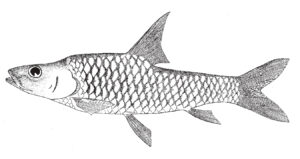
Tor remadeviii. From: Kurup, B. M. and K. V. Radhakrishnan. 2011. Tor remadevii, a new species of Tor (Gray) from Chinnar Wildlife Sanctuary, Pambar River, Kerala, southern India. Journal of the Bombay Natural History Society 107 (3): 227‒230. [Publication dated Sept.-Dec. 2010 but published Oct. 2011.]
Tor remadeviae > remadevii Madhusoodana Kurup & Radhakrishnan 2011 – in honor of Karunakaran Rema Devi, Zoological Survey of India, a woman
Sinibrama melroseae > melrosei (Nichols & Pope 1927) – in honor of Mrs. J. C. Melrose, a missionary in China
Poecilocharax bovaliorum > bovalii Eigenmann 1909 – named for two men named Bovalius, presumably relatives
Hyphessobrycon peugeotorum > peugeoti Ingenito, Lima & Buckup 2013 – named for the Peugeot family (best known for their cars)
Bryconacidnuse ellisae > ellisi (Pearson 1924) — named for Marion Durbin Ellis, a woman
Hemibrycon gutierrezorum > gutierrezi Ardila Rodríguez 2020 – named for the philanthropic Gútierrez Gómez family
Pseudohemiodon almendarizae > almendarizi Provenzano-Rizzi, Argüello & Barriga-Salazar 2022 – in honor of Ana de Lourdes Almendáriz, a female herpetologist
Galeichthys troworum > trowi Kulongowski 2010 – named for a father and son
Neoarius midgleyorum > midgleyi (Kailola & Pierce 1988) – named for a husband and wife
Chasmocranus lopezae > lopezi Miranda Ribeiro 1968 – named for the woman who collected holotype
Gymnorhamphichthys bogardusae > bogardusi Lundberg 2005 – in honor of Joan Bogardus Spears (1939–2002), whose daughter supported Lundberg’s work
Notolepis coatsorum > coatsi Dollo 1908 – named for brothers who helped finance the Scottish National Antarctic Expedition
Sciadonus robinsorum > robinsi Nielsen 2018 – named for father-and-son ichthyologists
Callogobius clarkae > clarki (Goren 1978) – named for ichthyologist Eugenie Clark (1922–2015), a woman
Pictichromis paccagnellorum > paccagnellae (Axelrod 1973) – named for the Paccagnella family, Bologna, Italy, aquarium fish wholesalers who provided holotype
Lissonanchus lusherae > lusheri Smith 1966 – named for Mrs. D. N. Lusher, who collected holotype
Aphyosemion lambertorum > lambertori Radda & Huber 1977 – named for two killifish experts both named Lambert
Austrolebias vandenbergorum > vandenbergi (Huber 1995) – named for father-and-son aquarists
Fundulus herminiamatildarum > herminiamatildae García-Ramírez, Lozano-Vilano & De la Maza Benignos 2022 – named for two the first authors’ parents, Herminia Ramírez and Matilde García
Monolene mertensae > mertensi (Poll 1959) – in honor of Mrs. P. Mertens, who illustrated many of Poll’s publications
Acanthopagrus morrisonae > morrisoni Iwatsuki 2013 – in honor of Sue M. Morrison, who collected type specimens and tissue samples
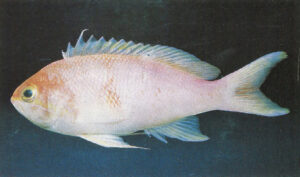
Pseudanthias engelhardi. Photo by Roger C. Steene. From: Allen, G. R. and W. A. Starck II. 1982. The anthiid fishes of the Great Barrier Reef, Australia, with the description of a new species. Revue française d’Aquariologie Herpétologie 9 (2): 47–56.
Bembrops greyae > greyi Poll 1959 – named for Marion Grey (1911–1964), Chicago Natural History Museum, a woman
Pseudanthias engelhardorum > engelhardi (Allen & Starck 1982) – named for philanthropist Charles W. Englehard, Jr. (1917–1971) and his family
Lepidotrigla larsonae > larsoni del Cerro & Lloris 1997 – in honor of goby expert Helen Larson
Paraliparis freebornae > freeborni Stein 2012 – in honor of scientific illustrator Michelle Freeborn
For several eponyms, the ECoF editors opted to retain the emended spellings because they, in their assessment, are in “prevailing usage.” According to Article 33.2.3.1, “when an unjustified emendation is in prevailing usage and is attributed to the original author and date it is deemed to be a justified emendation.” In other words, if I change the grammatical spelling of an eponym, which Article 32.5.1 says I cannot do, but other taxonomists start using my spelling, then, per Article 33.2.3.1, my emended spelling is okay.
According to ECoF, these species-group names meet the “prevailing usage” criteria:
Myxine robinsorum Wisner & McMillan 1995 – originally spelled robinsi, named for both C. Richard Robins and his wife Catherine
Squaliolus aliae Teng 1959 – originally spelled alii, in honor of the author’s wife
Cobitis battalgilae Bacescu 1962 – originally spelled battalgili, in honor of Turkish ichthyologist Fahire Battalgil (later Battalgazi) (1905–1948), a woman
Pangio mariarum (Inger & Chin 1962) – originally spelled mariae, in honor of the authors’ wives, both named Maria
Oxynoemacheilus veyselorum Çiçek, Eagderi & Sungur 2018 – originally spelled veyseli, named for father and son of first author, both named Veysel
Physoschistura raoi (Hora 1929) – originally spelled raoe, named for H. Srinivasa Rao (1894–1971), Zoological Survey of India, a man
Notropis cummingsae Myers 1925 – originally spelled cummingsi, in honor of Mrs. J. H. Cummings (1885–?), an amateur naturalist

Tewara cranwellae. From: Griffin, L. T. 1933. Descriptions of New Zealand fishes. Transactions of the New Zealand Institute 63: 171–177, Pls. 24–25. Illustration by the author.
Panaque suttonorum Schultz 1944 – originally spelled suttoni, named for Dr. and Mrs. Fredrick A. Sutton, who helped Schultz in Venezuela
Callopanchax sidibeorum Sonnenberg & Busch 2010 – originally spelled sidibei, named for Samba Sidibe and his family, who first collected this species
Tewara cranwellae Griffin 1933 – originally spelled cranwelli, named for botanist Lucy Cranwell (1907-2000), a woman
If anything, this exercise demonstrates the seemingly contradictory objectives of ICZN Articles 31.1.2, 32.5.1 and 33.2.3.1.
20 December
Semotilus atromaculatus (Mitchill 1818)
I have an unbreakable rule when it comes to researching the etymologies of fish names: Do not rely on secondary sources, such as regional “Fishes of …” books, no matter how good they are. Instead, always begin with the original publication in which the name was proposed. I apparently broke this rule with the specific epithet of the Creek Chub Semotilus atromaculatus, a common minnow of the eastern United States and Canada.
Physician-politician-naturalist Samuel L. Mitchill (1764–1831) described the species as Cyprinus atromaculatus in 1818. The specific name means “black spotted.” Some references, including ETYFish, tell you that the black spot in question is the black spot at the anterior edge of the dorsal-fin base. This explanation is given in two major books: Freshwater Fishes of Virginia (Jenkins & Burkhead, 1994) and Fishes of Alabama (Boschung & Mayden, 2004). Indeed, the dorsal-fin spot is a major diagnostic character of the species.
The trouble is, Mitchill never mentioned this dorsal spot in his brief description. Instead, he mentioned that the fish’s back, sides, belly and fins are “marked by black dots, consisting of a soft or viscous matter, capable of being detached by the point of a knife without lacerating the skin …”.
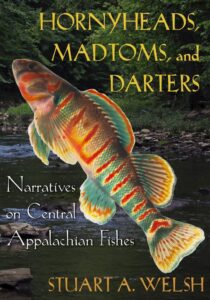 I learned of this discrepancy while reading Hornyheads, Madtoms, and Darters: Narratives on Central Appalachian Fishes, a new (October 2023) book by Stuart A. Welsh, Adjunct Professor of Ichthyology in the Wildlife and Fisheries Resources program at West Virginia University. This excellent and highly readable book is a collection of 23 essays on the fishes of central Appalachia, with an emphasis on ecology and the contributions of “old school” naturalists such as Mitchill. In the chapter titled “Spots and Dots,” Welsh posits that the “black dots” of Mitchill’s specimen are external black cysts that contain a parasitic flatworm called a trematode. This condition is often called Black Spot Disease. I have collected many Creek Chub (a common fish where I live) and several other species covered with these unsightly black spots.
I learned of this discrepancy while reading Hornyheads, Madtoms, and Darters: Narratives on Central Appalachian Fishes, a new (October 2023) book by Stuart A. Welsh, Adjunct Professor of Ichthyology in the Wildlife and Fisheries Resources program at West Virginia University. This excellent and highly readable book is a collection of 23 essays on the fishes of central Appalachia, with an emphasis on ecology and the contributions of “old school” naturalists such as Mitchill. In the chapter titled “Spots and Dots,” Welsh posits that the “black dots” of Mitchill’s specimen are external black cysts that contain a parasitic flatworm called a trematode. This condition is often called Black Spot Disease. I have collected many Creek Chub (a common fish where I live) and several other species covered with these unsightly black spots.
Black Spot Disease is caused by digenean trematodes (flukes) of the families Diplostomatidae and Heterophyidae. The raised black “spots” (actually nodules) are where the parasite has encysted itself in the skin of the fish. The fish serves as a second intermediate host for the trematode. They acquire the parasite from infected snails, the first intermediate host. When fish-eating birds and mammals eat the infected fish, trematode eggs within the feces are released into the water. When the eggs hatch, they parasitize the snails. Then the larvae transform into a free-swimming form, whereupon they infect fish. The cycle then continues.
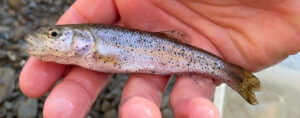
Semotilus atromaculatus with Black Spot Disease (genus Neascus), Fletcher’s Creek, Ontario, Canada. Photo by Noah Poropat. Source: Wikipedia.
I have not conducted an exhaustive literature search, but I believe Dr. Welsh is the first person to offer the trematode explanation for “atromaculatus.” It clearly makes sense, especially since Mitchill described the black dots as “soft or viscous matter, capable of being detached by the point of a knife without lacerating the skin …”. The ETYFish entry has been revised.
Dr. Welsh mentions the etymology of the generic name Semotilus: sema means banner (i.e., dorsal fin), and telia means spotted, referring to the black dorsal-fin spot that myself and others believed was referenced in the specific name atromaculatus. Most other “Fishes of …” books present a similar explanation. It’s probably correct, but etymologically it doesn’t make sense. The name was proposed by the eccentric naturalist Constantine Samuel Rafinesque in 1820. One of his eccentricities was a rather creative (some would say careless) command of Latin and Greek. At times he seems to have possessed a Latin or Greek dictionary consisting of words of his own spelling or invention. Semo– is probably derived from sēmeī́on (Gr. σημεῖον), meaning banner or dorsal fin. But the second half of the name, does not track with any known Greek word. In 1878, David Starr Jordan, who often criticized Rafinesque’s nomenclatural “monstrosities,” simply presumed that Rafinesque believed it to mean “spotted.” This explanation has survived to the present.
According to Holger Funk, our resident Greek and Latin scholar, tilus sounds like a Latinization of τίλος (tílos), plucked, which obviously doesn’t make any sense here. Another Greek word vaguely reminiscent of “tilus” is téleios (τέλειος) which, however, does not mean “spotted.” In fact, it means the opposite — “perfect” or “without spot or blemish.” Another possibility is that –tilus is nothing more than a suffix with no specific meaning on its own, only used in combination with a preceding word component.
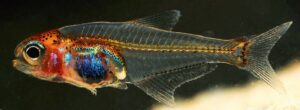
Cyanogaster noctivaga, paratype, photographed right after capture at night. From: Mattox, G. M. T., R. Britz, M. Toledo-Piza and M. M. F. Marinho. 2013. Cyanogaster noctivaga, a remarkable new genus and species of miniature fish from the Rio Negro, Amazon basin (Ostariophysi: Characidae). Ichthyological Exploration of Freshwaters 23 (4) (for 2012): 297–318.
13 December
Cyanogaster noctivaga Mattox, Britz, Toledo-Piza & Marinho 2013
Some biological nomina are just perfect. They accurately describe the distinguishing features of the species in question. But then they do a little extra. They also describe some aspect of the species’ behavior or biology. And they do so with an interesting combination of Latin or Greek words. Cyanogaster noctivaga is one such name.
During an October 2011 expedition to Santa Isabel do Rio Negro (Amazonas State), a small village on the left bank of the upper Rio Negro in the Amazon basin, the authors collected several specimens of what they described as a “remarkable miniature fish,” not more than 17.4 mm long, and not assignable to any of the characid genera known at the time. The authors were struck by its large eyes, its odd-looking snout, mouth and teeth, its completely transparent body, and the iridescent blue color of its abdominal region.
“The fish appeared as a fast-swimming blue streak in the net,” Ralf Britz said.
One other odd or remarkable thing about the fish: They could only catch it at night.
Based on the shape and number of its teeth, Mattox et al. knew they had a new genus, to which they gave the name Cyanogaster: cyano, from kýanos, Greek for blue, and gastḗr, Greek for belly or stomach, referring to its conspicuous blue belly.
The specific epithet noctivaga is quite evocative. It’s a combination of nox, Latin for night, and vaga, from vagare, Latin for to wander, roam or walk about, referring to its presumed nocturnal habits.
In other words, the Blue-bellied Night Wanderer.
Biological nomina don’t get much better than that.
6 December
The gruesome legacy of Morton Allport
The Wikipedia entry (as of today) for Morton Allport (1830–1878) describes an “ardent and accomplished naturalist” who, “by his original work added largely to the knowledge of the zoology and botany of Tasmania.” The entry singles out his work with fishes and how he “made it his concern to send specimens of every new fish he could procure to the best authorities of England and elsewhere.” Indeed, six species have been named in honor of Allport, two of which remain valid today:
Splendid Sea Perch Callanthias allporti Günther 1876, found off southern Australia and New Zealand
Barred Grubfish Parapercis allporti (Günther 1876), found in the Eastern Indian Ocean, in southern Australia, from South Australia to New South Wales and Tasmania
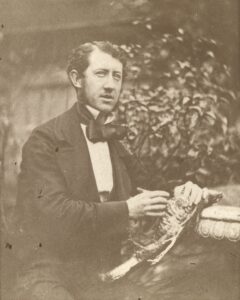
Morton Allport in 1854. © Allport Library and Museum of Fine Arts, State Library of Tasmania. The library/museum was founded by Morton’s grandson Henry Allport (1890-1965). The institution “respectfully acknowledges the lasting trauma experienced by Palawa/Tasmanian Aboriginal people that has resulted from the actions of Morton Allport and other individuals in the name of scientific research.”
Wikipedia does not mention that Allport was also a collector of human remains, specifically those of Aboriginal Tasmanian people, which he sent to European museums. According to new research published in the peer-reviewed journal Archives of Natural History, Allport resorted to graverobbing and corpse mutilation to collect these remains.
The paper, written by Jack Ashby, assistant director of the University of Cambridge Museum of Zoology, details a gruesome story involving the remains of William Lanne, who was thought to be the last Tasmanian Aboriginal man alive before his death in 1869. Lanne’s body was taken to a local hospital with plans for burial. But a man under Allport’s direction broke into the hospital and stole various parts of Lanne’s corpse. Later, Allport ordered the exhumation of Lanne’s grave to retrieve what was left of his skeleton.
Allport also served as vice president of the Royal Society of Tasmania. In 1878, the Society exhumed the hidden remains of Truganini, said to be the last-known surviving Tasmanian Aboriginal woman. Truganini had requested to be cremated to avoid having her remains become a museum exhibit but was buried anyway. The Royal Society displayed her skeleton until 1947.
These events occurred against a backdrop during which many Aboriginal women were being kidnapped by whalers, sealers and other settlers, and taken to islands where they were often tortured, enslaved and raped. There is no evidence that Allport participated in any of these crimes, but he certainly supported and benefited from a colonial government that allowed settlers to murder Tasmanian Aboriginal people without punishment. In fact, the number of Aboriginal people declined from around 6,000 in 1804 to fewer than 300 by the time Allport arrived in Tasmania. Their scarcity and near extinction increased the value of their remains and incentivized Allport to collect them even more.
Ashby’s study also recounts how Allport sought out the carcasses of thylacines — also known as Tasmanian tigers — which were being hunted into extinction because they were perceived to be a threat to livestock. (According to Ashby, the more likely culprit were dogs trained by colonists to hunt kangaroos.) When Allport sent these carcasses to European museums, he did not request money. Instead, he explicitly requested “quid pro quo” commendations for his efforts in the form of “accolades from elite international scientific institutions.” (The last surviving thylacine died in 1936.)
Allport’s story is another example of how 19th-century natural history collections are often linked with colonial genocide and brutality, and how natural history museums are grappling with the tainted legacies of their collections.
Details are not available of how Allport acquired the fishes for which he is named. Wikipedia – drawing on the Dictionary of Australasian Biography – described him as an “authority” on Tasmanian fishes who “catalogued, described and drew pictures of his specimens.” In addition, Allport is described as a “leader in the introduction of salmon and trout to Tasmanian waters and also introduced the white water-lily and the perch.” Today, exotic trout and salmon pose a major threat to the island’s endemic population of galaxiid fishes.
In addition to Ashby’s paper (link above), the University of Cambridge has posted a well-illustrated summary.
29 November
Amazonichthys Esguícero & Mendonça 2023
Women rule in the newly proposed tetra genus Amazonichthys.
First, there’s the generic name. Amazon refers not to the Amazon River basin of Brazil, where all three included species occur, but to the fabled Amazons of Greek mythology, a race of warrior women from which the Amazon gets its name. (Ichthys, of course, means fish.)
According to legend, the name “Rio Amazonas” was first used when a native tribe, the Icamiabas, battled against Spanish troops led by Francisco de Orellana, a Spanish explorer and conquistador, in 1542. Orellana described the river as “the river of the Amazons,” referring to the mythical Amazons of Asia described in Greek legends, because the Icamiabas warriors were led by women. “Icamiabas” roughly translates as “broken breasts,” suggesting that the warriors’ right breasts were either flattened or mutilated for better use of a bow and arrow, just like the Amazons of Greek mythology.
The word “Amazon” itself may be derived from the Iranian compound ha-maz-an- “(one) fighting together” or ha-mazan “warriors.” Some scholars claim that the name is derived from the Tupi word amassona, meaning “boat destroyer.” Other derivations have also been proposed.
Just as the Amazons were an all-female tribe, Amazonichthys is an all-female genus: All three included species are named in honor of women.
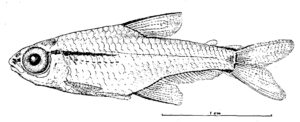
Amazonichthys lindae, holotype, 20.6 mm SL. From: Géry, J. 1973. New and little-known Aphyoditeina (Pisces, Characoidei) from the Amazon Basin. Studies on the Neotropical Fauna v. 8: 81–137.
The type species Amazonichthys lindeae was proposed as Axelrodia lindeae, by Jacques Géry in 1973. Géry named it in honor of Linde Geisler, who collected the holotype with German aquarist Rolf Geisler (1925–2012), presumably her husband. Ichthyologists have long known that this species is morphologically distinct from the other species of Axelrodia, with some authors questioning the monophyletic status of the genus. After a detailed study of the species, the authors of Amazonichthys erected a new genus for Axelrodia lindeae and described two new species, both named after modern-day “warriors” for conservation, education and women’s rights:
Amazonichthys camelierae is named in honor of Priscila Camelier, Universidade Federal da Bahia (Brazil), an “outstanding ichthyologist, passionate teacher, and strong women’s rights activist.”
Amazonichthys lu is named in honor of biologist Luciana Leite, known by her friends as “Lu,” for her “incredible enthusiasm and work towards the conservation of South American flora and fauna and for her endless fight in favor of women’s rights.”
Despite being an “all-female” genus, Amazonichthys is a grammatically masculine name. Why? Because in Latin, “ichthys” is a masculine noun.
For more information about Amazonichthys, see: Esguícero, A. L. H. and M. B. Mendonça. 2023. A new genus and two new species of tetras (Characiformes: Characidae), with a redescription and generic reassignment of Axelrodia lindeae Géry. Ichthyology & Herpetology 111, No. 3, 2023, 426–447.
22 November
An ETY-torial
Biological nomina are not monuments; they’re tools
Recent proposals to rename biological nomina on ethical and ideological grounds (see 24 March 2021 NOTW and 3 May 2023, below) reflect efforts among society at large to remove monuments that commemorate people associated with racism and imperialism, and to rename buildings, schools, streets and other locations named in their honor (e.g., Confederate statues in the U.S. and the “Rhodes Must Fall” movement in South Africa). But biological nomina are different from public-facing entities. They are not named by local government officials and community leaders. They are not named as an expression of a community’s shared values, and cannot be removed or changed when those values change. Biological nomina are created by biologists — often just one, sometimes a few, but never by consensus or committee — for use by other biologists. With the exception of serious amateur naturalists (aquarists, herpers, birders, butterfly collectors, etc.), the general public has little exposure to and awareness of the scientific names biologists use in their professional communications and publications.

Eleotris soaresi. Illustration by George Henry Ford. From: Playfair, R. L. and A. Günther. 1867. The fishes of Zanzibar, with a list of the fishes of the whole east coast of Africa. London. [Reprinted in 1971, with a new introduction by G. S. Myers and a new foreword by A. E. Gunther; Newton K. Gregg, publisher, Kentfield, California.]. i-xiv + 1-153, Pls. 1-21.
One thing I’ve learned since I began studying fish-name etymologies in 2009 is that most ichthyologists are not curious about the names of the fishes they’re studying. (If they were, The ETYFish Project would probably not exist.) Except for the names of taxa they describe themselves, most systematic studies of fishes do not include etymologies. In a recent redescription of Eleotris soaresi, the authors provide detailed morphometric data that confirm it as a valid species but do not explain the meaning of its name (Mennesson and Keith, 2020). I suspect that for them, “Eleotris soaresi” is not a monument to someone named Soares the same way a statue or the name of a building might be. It’s simply a name, a label on a museum jar, an entry in a checklist, a clade on a cladogram, a unique arrangement of letters that facilitates communications about this particular species and separates it from the other two million-plus named species of the world. Changing “soaresi” to something else would sever the link to Playfair’s original description and specimen. For biologists, the legacy of Playfair’s original description and specimen is more important than the legacy of the person for which it was named.
The sins of the past — slavery, genocide, racism, sexism, imperialism, colonialism — should not be ignored. But the wounds of these sins cannot be healed by changing the scientific names of plants and animals. They can only be healed by studying the past and making sure we don’t repeat it. The ETYFish Project has detailed the uncomfortable truths and regrettable histories behind many fish epithets. The path ahead is paved by knowing what came before.
15 November
Schindleria squirei Robitzch, Landaeta & Ahnelt 2023
In 1971, the progressive rock band Yes included a song called “The Fish (Schindleria praematurus)” on their album Fragile. Fifty-two years later, a new species of Schindleria has been named for the composer and featured soloist of that song, the band’s bassist and backing vocalist Chris Squire (1948-2015). Unfamiliar with the song, I had to check it out. And then I had to answer this burning question:
Why is there a song named for one of the most enigmatic little fishes in the world?
But first, some background regarding Schindleria.
Schindleria are pelagic reef fishes from the southern Pacific Ocean usually no more than 2 cm long. They’re called “infantfishes” because they retain larval features even as adults (a condition known as paedomorphosis). Their bodies are transparent and some of their bones do not develop. Yet despite their larval appearance they reproduce quickly and often, up to 7-9 generations per year. And despite their abundance — one study suggests they’re the most numerous coral-reef fishes in the world — infantfishes are seldom noticed because of their small size and transparency.

First-published images of Schindleria praematura, male above, female below. From: Schindler, O. 1932. Sexually mature larval Hemirhamphidae from the Hawaiian Islands. Bulletin of the Bernice P. Bishop Museum No. 97: 1-28, Pls. 1-10.
The first infantfish was described as Hemiramphus praematurus by German zoologist Otto Schindler (1906-1959) in 1930. Schindler was clearly puzzled by the fish, believing it to be a sexually mature larval halfbeak (hence its initial placement in Hemiramphus). The specific epithet, an adjective, connotes its premature (larval) appearance. Schindler described a second species the next year, Hemiramphus pietschmanni, naming it for ichthyologist Viktor Pietschmann (1881-1956), who collected the holotype. In 1934, Belgian ichthyologist Louis Giltay (1903-1937) questioned Schindler’s placement of the species in the family Hemiramphidae. Giltay created a new genus, Schindleria, and a new family, Schindleriidae, honoring Otto Schindler, but still wasn’t sure where to place them. He leaned towards Blenniiformes but wanted to devote time to study the issue. (He died three years later.) Subsequent researchers have since placed Schindleriidae within the goby order Gobiiformes. A 2009 phylogenetic analysis placed the genus within the goby family Gobiidae, thereby making Schindleriidae a junior synonym of Gobiidae. In other words, they’re paedomorphic gobies. The ETYFish Project follows this classification but Eschmeyer’s Catalog of Fishes does not.
According to one molecular analysis, there may be more than 30 cryptic species of Schindleria in the western Pacific. Since Schindler’s description of the second species in 1931, nine more species have been described — all since 2004 — including the most recent, Schindleria squirei, from Rapa Nui (Easter Island, Chile).
Unless you were an ichthyologist, Schindleria praematura (note the correct spelling of the adjectival specific epithet when placed in a feminine genus) was hardly a well-known fish in the early 1970s. So how did this larvae-like curiosity end up on the radar of a rock musician? And why did he name a song — actually an instrumental track with some singing of the fish’s name near the end — after it? Per Wikipedia and a few others sources, the story goes like this:
Chris Squire’s nickname was “The Fish.” He earned it because he took very long baths (a problem when the band shared a house in the early days of their career), and because his astrological sign was Pisces. Another reason is that Squire’s instrument and the low-frequency sound it generates — bass — is also the name of a fish. Squire apparently did not mind the nickname. His 1975 solo album is titled Fish Out of Water.
According to band lore, Squire had composed a melody and wanted to sing the name of a fish that was eight syllables long. Michael Tait, the band’s roadie, was dispatched to find one. Tait found the name Schindleria praematurus (still using the grammatically incorrect –us spelling) in a copy of the Guinness Book of World Records. (I believe S. prematura was considered the smallest known vertebrate at the time.) The rest, as they say, is musical history.
And now ichthyological history as well.
Footnote: In 2011, a species of fossil fish was named Tarkus squirei in Squire’s honor, referencing his nickname.
8 November
Gods and goddesses
Many fishes are named for Greek gods and goddesses. Eos (dawn). Pluto (underworld). Zephyrus (westerly wind). Hephaestus (fire). Hypnos (sleep). Thanatos (death). Selene (moon). Iris (rainbow). Nyx (night and darkness). Aphrodite (love and beauty). Hera (marriage, women and family). Apollo (music, poetry, medicine and archery). Poseidon (the sea).
These five are particularly interesting:
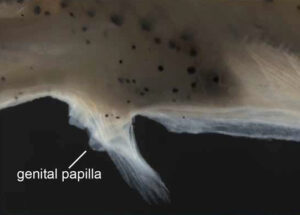
Danionella priapus, male holotype, 14.4 mm SL, close-up of modified pelvic fins and conically projecting genital papilla. From: Britz, R. 2009. Danionella priapus, a new species of miniature cyprinid fish from West Bengal, India (Teleostei: Cypriniformes: Cyprinidae). Zootaxa 2227: 53-60.
Danionella priapus Britz 2009 The five species of Danionella, found in freshwater habitats in Myanmar and India, are among the smallest vertebrates in the world, reaching just 10-15 mm. One species, known only from Jorai River, upper Brahmaputra River basin, East Bengal, India, is named for Priapus, the Greek god of fertility. The name refers to the conical projection of genital papilla in males, which superficially resembles the penis of mammals.
Danio aesculapii Kullander & Fang 2009 A close relative of Danionella priapus is Danio aesculapii, found in small freshwater streams on the western slope of Rakhine Yoma, Myanmar. It’s named for Aesculapius, the Greek god of medicine, who was equipped with a staff with one or two snakes wrapped around it. The allusion refers to the fish’s snakeskin pattern and the “snakeskin” epithet used in the European aquarium trade.
Trimma maiandros Hoese, Winterbottom & Reader 2011 This widespread pygmy goby from the Indo-Pacific is named for the Greek god of the winding Meander River in Phrygia (now the Büyük Menderes River in Turkey), and the origin of the Anglo-Saxon word meander (a winding or crooked course). It refers to the zigzag pattern of gray-to-blue lines on the goby’s body.

Pseudojuloides zeus, male holotype, 60 mm SL. Photo by Benjamin C. Victor. From: Victor, B. C. and J. M. B. Edward. 2015. Pseudojuloides zeus, a new deep-reef wrasse (Perciformes: Labridae) from Micronesia in the western Pacific Ocean. Journal of the Ocean Science Foundation 15: 41-54.
Pseudojuloides zeus Victor & Edward 2015 This deep-reef pencil wrasse from Palau and Majuro, Micronesia, is named for the Greek god Zeus, who cast bolts of lightning at unsuspecting mortals. The name refers to the wrasse’s jagged blue stripes on its sides, which resemble lightning bolts.
Varicus prometheus Fuentes, Baldwin, Robertson, Lardizábal & Tornabene 2023 This recently described goby from a deep reef off Roatan, Honduras, is named for the Greek god Prometheus, who, as punishment from the god Zeus, had his liver eaten out by an eagle, only to have the liver grow back overnight so it might be eaten again the next day. The name refers to the fact that the abdomen of the holotype was partially eaten by a hermit crab.
 1 November
1 November
John R. Paxton (1938-2023)
John R. Paxton of the Sydney Museum (Australia) passed away early Sunday morning. He had been unwell for some months and passed in his sleep.
John was born in the USA in 1938. He completed his Ph.D. at the University of Southern California in 1968. Shortly thereafter, he succeeded Gilbert P. Whitley as Curator of Fishes at the Sydney Museum. John “retired” in 1998 but continued his research on deep-sea fishes as a Senior Fellow.
In an email informing colleagues of John’s passing, Amanda Hay, Collection Manager, Ichthyology, Australian Museum Research Institute, wrote:
“His legacy for the AMS Ichthyology collection is profound. Reorganizing the collection and bringing it into the modern era, he also set about a vigorous collecting program, not only of deep-sea fishes, but also coastal, estuarine and freshwater species and always encouraged the use of the collection. John mentored many students, teaching a popular ichthyology course at Macquarie University in the 1970s and supervising PhD, masters, and honours students.
“Building community nationally and internationally was key to John’s working life, bringing ichthyologists together to share knowledge. Alongside Doug [Hoese] they founded the Australian Society for Fish Biology in 1971 and the Indo-Pacific Fish Conference in 1981. John was a part of several iconic expeditions including Lord Howe Island in 1973, which contributed to Lord Howe Is being given a World Heritage listing and the first AM trip to Lizard Island.”
John had published over 100 scientific papers, including descriptions of 16 new species and nine new genera, and two major books: Encyclopaedia of Fishes (1994, with William Eschmeyer) and Fishes, Zoological Catalogue of Australia (2006).
Twenty fish species have been named in John’s honor:
NETTASTOMATIDAE
Nettenchelys paxtoni Karmovskaya 1999
ENGRAULIDAE
Setipinna paxtoni Wongratana 1987
ALEPOCEPHALIDAE
Conocara paxtoni Sazonov, Williams & Kobyliansky 2009
STERNOPTYCHIDAE
Polyipnus paxtoni Harold 1989
STOMIIDAE
Eustomias paxtoni Clarke 2001
Photonectes paxtoni Flynn & Klepadlo 2012
MACROURIDAE
Ventrifossa paxtoni Iwamoto & Williams 1999
Ventrifossa johnboborum Iwamoto 1982
CETOMIMIDAE
Cetomimus paxtoni Kobyliansky, Gordeeva & Mishin 2023
BYTHITIDAE
Bidenichthys paxtoni (Nielsen & Cohen 1986)
SYNGNATHIDAE
Corythoichthys paxtoni Dawson 1977
CALLIONYMIDAE
Synchiropus paxtoni Fricke 2000
GEMPYLIDAE
Rexichthys johnpaxtoni Parin & Astakhov 1987
CHIASMODONTIDAE
Pseudoscopelus paxtoni Melo 2010
MALACANTHIDAE
Branchiostegus paxtoni Dooley & Kailola 1988
GIGANTACTINIDAE
Gigantactis paxtoni Bertelsen, Pietsch & Lavenberg 1981
TETRAODONTIDAE
Torquigener paxtoni Hardy 1983
OSTRACOBERYCIDAE
Ostracoberyx paxtoni Quéro & Ozouf-Costaz 1991
ANTHIADIDAE
Acanthistius paxtoni Hutchins & Kuiter 1982
LIPARIDAE
Careproctus paxtoni Stein, Chernova & Andriashev 2001
In addition, a subfamily and genus have been named for Paxton as well:
APOGONIDAE Subfamily Paxtoninae
Paxton Baldwin & Johnson 1999
named for friend and colleague John R. Paxton, Australian Museum (Sydney), who provided type specimens, as a “good-natured reminder that ‘you can’t judge a fish by its cover’” (Paxton initially believed that the specimens represented an undescribed genus of grammastin serranid]

Hoplocharax goethei. From: Géry, J. 1966. Hoplocharax goethei, a new genus and species of South American characoid fishes, with a review of the sub-tribe Heterocharacini. Ichthyologica, the Aquarium Journal 38 (3): 281–296.
25 October
Hoplocharax goethei Géry 1966
French plastic surgeon-turned-ichthyologist Jacques Géry (1917–2007) described Hoplocharax goethei, a biting tetra (Acestrorhynchidae) from the Amazon and Orinoco basins of Brazil and Colombia in 1966. He named it after the recently deceased Charles M. Goethe (1875–1966) of Sacramento, California, USA, “for his support of scientists and students in the fields of biology, conservation, and education.” Géry did not explain the support Goethe had provided, nor whether he himself had any association with him. It’s interesting to note, however, that Géry’s ichthyological colleague Martin R. Brittan (1922–2008) — whom Géry thanked in the description — taught at Sacramento State College. Brittan certainly was familiar with Goethe, and perhaps even knew him, since Goethe founded Sacramento State College (now California State University, Sacramento, or CSUS) in 1947, and regularly gave the college money for research projects and library acquisitions, including a large endowment after his death.

Portrait of Charles M. Goethe from a booklet produced for “C.M. Goethe National Recognition Day,” March 28, 1965.
In return for his money, the college turned a blind eye to Goethe’s widely known support of eugenics, and his admiration for Nazi Germany. He was fascinated by the “science” of “racial hygiene.” He dismissed early reports on Hitler’s racial policies as liberal and Jewish propaganda. In fact, he said the Nazi sterilization program was “administered wisely, and without racial cruelty.” And one of his last financial donations, made three months before his death, was to a white supremacist organization in the Netherlands working to build “cooperation between all the Nordic Peoples” — “the best, most intelligent and highest cultured Peoples of the world” — against the “worthless peoples of Africa and Asia.”
In 1965, CSUS announced with great fanfare that it was naming its new science building after Goethe. Students and faculty protested, comparing Goethe to Dr. Strangelove, the eponymous ex-Nazi in Stanley Kubrick’s 1964 black comedy film. CSUS officials accused the protesters of libel but later quietly dropped Goethe’s name from the building.
It’s not known whether Géry knew any of this when he described the species, but Brittan almost certainly did. Goethe was very public about his beliefs. They were an open secret on campus. As long as he kept writing checks, CSUS was more than happy to cash them.
In 2005, CSUS changed the name of its Charles M. Goethe Arboretum to University Arboretum. No official reason was given, but everybody knew why.
A note on Hoplocharax: Géry proposed Hoplocharax as a new monotypic genus for H. goethei. The second half of the name is from Charax, typical genus of the Characiformes, from chárax (Gr. χάραξ), a pointed stake of a palisade, referring to densely packed sharp teeth, a common root-name formation in the order. The first half is from hóplon (Gr. ὅπλον), shield or armor (but here meaning armed), which Géry said referred to the fish’s strong and pointed pectoral fin spine and its three opercular spines. Curiously, Géry did not mention the dorsal and ventral spines on the caudal peduncle, clearly evident in his illustration (shown above).

Akysis bilustris, holotype, 25.3 mm SL. From: Ng, H. H. 2011. Akysis bilustris, a new species of catfish from southern Laos (Siluriformes: Akysidae). Zootaxa 3066: 61-68.
18 October
10th anniversary NAME OF THE WEEK
Akysis bilustris Ng 2011
Two days ago, 16 October, marked the 10-year anniversary of The ETYFish Project going online and the first weekly “Name of the Week” posting (about the Umpqua Chub Oregonichthys kalawatseti). I wanted to commemorate the milestone by featuring a fish name that had something to do with 10 years. For example, a 10th wedding anniversary gift is traditionally tin or aluminum, symbolizing the strength and resilience of marriage. So, I scoured ETYFish entries to see if a fish has been named for having a tin- or aluminum-like color or appearance. I couldn’t recall any offhand but, with 42,806 entries to date, I sometimes forget about names I researched, you know, a decade ago. I found no references to tin and only one for aluminum: a fish whose description was financed by an aluminum production company!
I then turned to names based on the Greek word dekas, meaning 10. There are many such names for fishes with 10 spines, 10 fin rays, 10 lateral-line canals, that sort of thing. They’re all perfectly fine names but perhaps a bit too utilitarian to list and discuss here.
And then I recalled a fish that’s actually named for a decade. And so, I feature it this week:
Akysis bilustris is a catfish (Akysidae) from the Mekong River drainage in southern Laos. It was described by Heok Hee Ng, an expert in Asian catfishes at the Lee Kong Chian Natural History Museum of the National University of Singapore. The specific epithet is a Latin adjective that means “that lasts 10 years,” from bi-, meaning two, and lustrum, a period of five years. In other words, a decade.
Why a decade?
Because the specimens that Ng used to describe the new species were collected in two expeditions exactly 10 years apart: 22 May 1999 and 22 May 2009.
Here’s to another 10 years of ETYFish!
 11 October
11 October
Heteronarce bentuviai (Baranes & Randall 1989) in honor of Polish-born Israeli ichthyologist Adam Ben-Tuvia (1919–1999), Hebrew University of Jerusalem, for his valuable contributions to the knowledge of Israeli fishes
Etrumeus golanii DiBattista, Randall & Bowen 2012 in honor of Israeli ichthyologist Daniel Golani, Hebrew University of Jerusalem, who provided type specimens, genetic material and a photograph of the holotype
Nun Bănărescu & Nalbant 1982 Aramaic (the language of the Talmud) word for fish (in this case, Nun galilaeus, described from Israel)
Acanthobrama lissneri Tortonese 1952 in honor of the late Helmut Lissner (1895–1951), Polish-born Israeli ichthyologist, a “keen ichthyologist who greatly furthered the investigations on the fishes of Lake Tiberias” (or Sea of Galilee), Israel, type locality
Acanthobrama telavivensis Goren, Fishelson & Trewavas 1973 –ensis, Latin suffix denoting place: Tel Aviv, Israel, near type locality at Yarkon Springs
Mirogrex hulensis Goren, Fishelson & Trewavas 1973 –ensis, Latin suffix denoting place: Lake Huleh, Israel, type locality (now extinct due to deliberate draining of lake in the 1950s)
Mirogrex terraesanctae (Steinitz 1952) of terra (L.), land, and sanctus (L.) holy, i.e., the Holy Land, referring to Lake Tiberias (or Sea of Galilee), Israel, where it is endemic
Siphamia goreni Gon & Allen 2012 in honor of Menachem Goren, Tel-Aviv University (Israel), who collected type, for his contribution to our knowledge of Red Sea fishes
Amblyeleotris steinitzi (Klausewitz 1974) in honor of the late Heinz Steinitz (1909–1971), marine biologist, herpetologist, and founder of the marine laboratory that bears his name, in Eilat, Israel, on the Gulf of Aqaba, where this goby occurs
Callogobius amikami Goren, Miroz & Baranes 1991 in honor of Amikam Gorovitch (no other information available), who was killed in a diving accident in Eilat, Israel, type locality
Hazeus elati (Goren 1984) of Elat (also spelled Eilat), Gulf of Aqaba, Red Sea, northern Red Sea, Israel, type locality
Priolepis goldshmidtae Goren & Baranes 1995 in honor of Ms. Orit Goldshmidt, Interuniversity Institute of Marine Sciences (Eilat, Israel), who collected holotype
Trimma mendelssohni (Goren 1978) in honor of Heinrich Mendelssohn (1910–2002), Tel Aviv University, for his “invaluable” contributions to zoological research and nature conservation in Israel
Astatotilapia flaviijosephi (Lortet 1883) in honor of Titus Flavius Josephus (37–c. 100), Romano-Jewish scholar, historian and hagiographer, who is mentioned several times in Lortet’s study of Lake Tiberias (Sea of Galilee in Israel); Flavius reported a thriving fishing industry on the lake and believed the occurrence of a catfish (Clarias gariepinus) in the lake was due to underground connections to the Nile
Sarotherodon galilaeus (Linnaeus 1758) –eus, Latin adjectival suffix: referring to Sea of Galilee (Lake Tiberias), Israel, type (now lost) locality
Tristramella sacra (Günther 1865) sacred, referring to Lake Tiberias (Sea of Galilee), Israel, type locality, in an area generally known as the “Holy Land”
Pseudochromis fridmani Klausewitz 1968 in honor of reef biologist David Fridman, Maritime Museum (Eilat, Israel), who collected holotype
Aseraggodes steinitzi Joglekar 1971 in honor of Heinz Steinitz (1909–1971), marine biologist, herpetologist, and founder of the marine laboratory that bears his name, in Eilat, Israel, on the Gulf of Aqaba, who sent specimens from the Red Sea and information about type locality
Dunckerocampus multiannulatus bentuviae Fowler & Steinitz 1956 in honor of ichthyologist Adam Ben-Tuvia (1919–1999), Hebrew University of Jerusalem, who collected type and contributed “interesting and valuable field notes” for many of the fishes Hebrew University and the Israel Sea Fisheries Research Station donated to the Academy of Natural Sciences of Philadelphia
Evoxymetopon moricheni Fricke, Golani & Appelbaum-Golani 2014 in honor of Mordechai (“Mori”) Chen, who found holotype drifting dead while snorkeling in the northern Gulf of Aqaba, Red Sea, in Israel; at first, he imagined the long, shiny object to be a strip of metal
Hoplolatilus oreni (Clark & Ben-Tuvia 1973) in honor of Oton H. Oren (1921–1983), chemist and oceanographer, Haifa Sea Fishery Research Station (Israel), who “helped in the collection of many Red Sea fishes”
Parascolopsis baranesi Russell & Golani 1993 in honor of Albert (Avi) Baranes (b. 1949), Director of the Interuniversity Institute for Marine Sciences (Eilat, Israel), through whose efforts this species was collected in the Gulf of Aqaba
Hyporthodus haifensis (Ben-Tuvia 1953) –ensis, Latin suffix denoting place: Sea Fisheries Research Station at Haifa, Israel, near Caesarea, Mediterranean Sea, type locality
Pterygotrigla spirai Golani & Baranes 1997 in honor of neurobiologist Micha E. Spira, founding Scientific Director of Interuniversity Institute for Marine Sciences (now Alexander Silberman Institute of Life Sciences, Elat [also spelled Eilat], Israel), for his contribution to marine science research in the Red Sea
4 October
Rineloricaria cachivera Urbano-Bonilla, Londoño-Burbano & Carvalho 2023

Paratypes of Rineloricaria cachivera. (a) Unpreserved specimen, río Vaupés at Resguardo Trub on. (b-c) MPUJ 14481, 114.4 mm standard length (LS), río Vaupés at Laguna Arcoiris small rocky bottom isolated lagoon from the river, Comunidad de Matapí, Mitú, Vaupés, Colombia. From: Urbano-Bonilla, A., Londoño-Burbano, A., & Carvalho, T. P. (2023). A new species of rheophilic armored catfish of Rineloricaria (Siluriformes: Loricariidae) from the Vaupés River, Amazonas basin, Colombia. Journal of Fish Biology, 1–12. https://doi.org/10.1111/jfb.15500
On 2 March 2019, Colombian ichthyologist Javier Alejandro Maldonado-Ocampo and two other researchers were crossing the swift, rocky waters of the Río Vaupés of Colombia when their small boat overturned. The two researchers made it to safety, but Maldonado-Ocampo was swept downstream. On Sunday, March 5, 73 kilometers from the accident site, his body was recovered by Brazilian soldiers who had joined the search party. Dr. Maldonado-Ocampo was 42 years old. (See NOTW, 13 March 2019.)
Two days before his tragic death, Maldonado-Ocampo — nicknamed “Nano” — collected a rheophilic (preferring or living in flowing water) armored catfish from the rapids of the río Vaupés. He collected it by hand, underwater in the rapids, wearing a diving mask. Over three years later, on 2 Aug. 2023, this catfish was formally described as a new species, Rineloricaria cachivera.
“Cachivera” is Spanish for a “flow of water that runs violently between the rocks” (i.e., rapids). “In the cosmology of the indigenous peoples of the Vaupés,” the authors write, “the waters of its rivers are inhabited by various supernatural creatures that must be venerated, consulted, and appeased in the rituals of the shamans; these creatures live and guard mainly the cachiveras of the rivers where humans are more fragile and face the greatest danger …”.
The catfish was named in memory of Maldonado-Ocampo, who, on 2 March 2019, the authors say, “stayed forever swimming in peace and happy with the rheophilic fish of the cachiveras of the Vaupés River.”
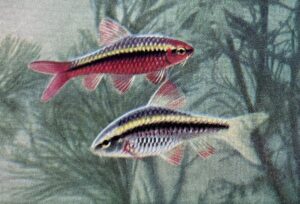
Cherry Barb, Rohanella titteya. From Innes’ Exotic Aquarium Fishes.
27 September
Rohanella Sudasinghe, Rüber & Meegaskumbura 2023
Rohanella is a monotypic genus recently proposed to accommodate the Cherry Barb, formerly known as Puntius titteya. The name is a Latin diminutive (-ella, which usually connotes endearment), in honor of Sri Lankan biologist Rohan Pethiyagoda (b. 1955).
Pethiyagoda was honored for two reasons: for recognizing (in 2012) that two species of Puntius, a catch-all genus for small barbs from Asia — P. titteya and P. bimaculata — warranted separate genera, and for his contributions to biodiversity research and guidance of young biodiversity researchers in Sri Lanka. (P. bimaculata is now in its own genus, Plesiopuntius, proposed by the same authors. In addition, they proposed the new genus Bhava for Puntius vittatus.)
It’s been an eventful year for Pethiyagoda. In June, he published a stinging rebuke of the efforts to exorcise biological nomenclature by changing scientific names, particularly eponyms, deemed offensive because they honor people historically connected to eras of imperialism and colonialism and/or who advocated sexist, racist, white supremacist, or pro-slavery views. (See the 24 March 2021 and 3 May 2023 [below] NOTWs for my views on revisionist nomenclature.)

In 2022, Rohan Pethiyagoda won the prestigious Linnean Medal of the Linnean Society of London, becoming the first Sri Lankan and only the second Asian to receive this award since its inception in 1888.
Pethiyagoda’s take is notable because he is writing from the perspective of a scientist who has spent most of his career in Sri Lanka, a developing country. He contends that “undoing the perceived harm that inappropriate names and terms can cause people who belong to oppressed communities in the developed world (the West) may harm the greater part of the global scientific community whose native language is not English.” In other words, biologists are seeking to “redress social problems in the English-speaking world … by imposing terminological and nomenclatural reforms also on the rest of the world.”
A few highlights from Pethiyagoda’s editorial:
On efforts to replace “colonial” names with indigenous names:
The 26-letter Latin alphabet is simply too restricted phonetically, as is clear from myriad potentially offensive historical transliterations such as ceylonensis [from Saheelan, a Persian name for the island: Imam, 1990], maderaspatensis [from Madrasan], and bombayensis [from Mumbai]. People in these countries know that these epithets are semantically flawed, but I have encountered no one who says their feelings are hurt by these historical errors.
On efforts to rename taxa named by authors suspected of unethical behavior:
Pethiyagoda (2021) highlighted 15 taxonomic papers published since 2018, involving a total of more than 3500 specimens belonging to some 80 species, all illegally collected and smuggled out of Sri Lanka. Should these publications be retracted? Should the new taxa described be invalidated? Perhaps they should, but the principal consequence of such actions would be the destabilization of biological nomenclature.
On efforts to rename eponyms:
In the absurd logic of Guedes et al. (2023), we must now rename physical units such as the Ampere, Celsius, Fahrenheit, Hertz, Joule, Kelvin, Newton, Volt and Watt; well-known minerals such as Alexandrite and Dolomite; popular garden plants such as Albizia, Banksia, Begonia, Bougainvillea, Camellia, Dahlia, Gardenia, Magnolia, Poinsettia and Wisteria; medically important organisms such as Escherichia, Klebsiella, Rickettsia and Salmonella; medical eponyms such as Alzheimer’s, Asperger’s, Hodgkin’s, Parkinson’s, Rorschach and Heimlich; geographic features such as Mount Everest and the Mariana Trench; and words in common use such as sandwich, diesel and pasteurize.
I could go on, but Pethiyagoda’s editorial is a free download. I highly recommend it.
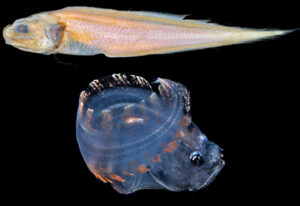
Adult holotype of Monomitopus ainonaka and a larval Monomitopus spp. (captured and photographed by A. Deloach, N. Deloach, and S. Kovacs) in Ianniello’s coil. From: Girard, M. G., H. J. Carter and G. D. Johnson. 2023. New species of Monomitopus (Ophidiidae) from Hawaiʻi, with the description of a larval coiling behavior. Zootaxa 5330 (no. 2): 265-279.
20 September
Monomitopus ainonaka Girard, Carter & Johnson 2023
The recent description of Monomitopus ainonaka, a new species of cusk eel (Ophidiidae), highlights, say its describers, the “importance of blackwater photography in advancing our understanding of marine larval fish biology.”
Blackwater diving is nightime SCUBA diving in water at least 180 m deep. The ocean is pitch black. At around 20 m, you drift with the current, as countless numbers of ocean creatures — primarily plankton and larval fishes that look nothing like their adult forms — ascend from the depths towards the surface (termed Diel Vertical Migration) to eat (or be eaten). At dawn they retreat to the depths. Blackwater photography is the art of capturing these creatures on film. These images allow biologists to see their intricate and delicate structures in situ and intact, prior to being damaged by nets and fixation in ethanol.
In 2021, blackwater divers photographed and collected a 14.4 mm SL larval fish with a large head and tapering body off the coast of Kona, Hawaiʻi. The authors identified it as a species of the genus Monomitopus but its DNA barcode did not match any of the six previously sequenced species within the genus. The authors then found a single unidentified specimen of Monomitopus collected North of Maui, Hawaiʻi, in 1972, within the Smithsonian Institution’s National Museum of Natural History Vertebrate Zoology Fishes Collection. Its fin-ray and vertebral/myomere counts overlapped those of the larval Hawaiian specimen. Based on these two specimens, the species was described as new. The author named it Monomitopus ainonaka, in honor of Ai Nonaka, United States National Museum, for her interest in ophidiid larvae and dedication to the discovery, identification and curation of larval fishes.
The name of the genus Monomitopus — proposed by British physician-naturalist Alfred William Alcock (1859-1933) in 1890 — translates as mono– (one), mitos (thread) and pus (from pous, foot), referring to how the ventral fin-rays of M. nigripinnis are fused to form a single filament.
In addition, blackwater photographs of the Hawaiian larva, two newly identified larvae of M. agassizii, and several uncollected larval Monomitopus, show the larvae contorting their bodies into a tight coil. The authors call this “Ianniello’s coil,” named after blackwater photographer Linda Ianniello for documenting a long behavioral sequence of M. agassizii and for her willingness to share her knowledge and images of larval fishes.
Ianniello explains her technique and her working relationship with scientists in this 6-minute video.
Other larval marine fishes coil their bodies, usually in response to a perceived threat (e.g., camera lights). Researchers have proposed that coiling is a form of Batesian Mimicry, whereby larvae are mimicking nutritionally poor gelatinous zooplankton (e.g., cnidarians, ctenophores, salps) to avoid predation. Larval Monomitopus, however, are found coiled most of the time. More research is needed to confirm the mimicry hypothesis.
13 September
Parabotia: Masculine or feminine?
The name of the loach genus Botia Gray 1831 is considered to be feminine in gender. This means that any specific epithets that are adjectives must be spelled to agree with the feminine gender. For example, the species Botia rostrata Günther 1868 — Latin for beaked — is spelled rostrata (feminine) instead of rostratus (masculine) or rostratum (neuter).
Since Botia is feminine, it stands to reason that subsequently described genus-level names ending in “-botia” should be feminine as well. And they are:
Leptobotia Bleeker 1870
Gobiobotia Kreyenberg 1911
Sinibotia Fang 1936
Chromobotia Kottelat 2004
Yet the loach genus Parabotia Guichenot 1872 is considered masculine. Why?

Botia almorhae. From: Day, F. 1878. The fishes of India; being a natural history of the fishes known to inhabit the seas and fresh waters of India, Burma, and Ceylon. Part 4: i-xx + 553-778, Pls. 139-195.
British naturalist John Edward Gray (1800-1875) did not indicate the gender of Botia when he proposed the genus for Botia almorhae, a loach from Almorha (now spelled Amora), Uttar Pradesh, India, in 1831. Nor did he explain what “Botia” means. However, Scottish physician-naturalist Francis Hamilton (1762–1829) used the same term for another Indian loach, Cobitis (now Paracanthocobitis) botia, described in 1822. Hamilton indicated that the local Assamese name for this species was “balli-potia,” which he apparently shortened to “botia.” (Note: several aquarium websites state that Botia is an “Asian” word for warrior or soldier but do not provide a source.)
The Code of the International Commission of Zoological Nomenclature provides a four-step process for determining the gender of genus-level names not formed from Latin or Greek.
ICZN 30.2.1. If a name reproduces exactly a noun having a gender in a modern European language (without having to be transliterated from a non-Latin alphabet into the Latin alphabet) it takes the gender of that noun.
Botia does not. So we go to step two:
ICZN 30.2.2. A name that is not formed from a Latin or Greek word takes the gender expressly specified by its author.
Gray did not specify a gender. So we go to step three:
ICZN 30.2.3. The name takes the gender indicated by its combination with one or more adjectival species-group names of the originally included nominal species
The species name Gray proposed, Botia almorhae, is a noun in the genitive (Almora’s Botia), not an adjective. So we go to the fourth and final step:
ICZN 30.2.4. If no gender was specified or indicated, the name is to be treated as masculine, except that, if the name ends in –a the gender is feminine, and if it ends in –um, –on, or –u the gender is neuter.
Botia ends in the letter “a”. So it’s feminine.
When Dutch ichthyologist Pieter Bleeker (1819–1878) proposed the genus Leptobotia (slender Botia) in 1870, he indicated that he regarded the genus as feminine by naming the type species Leptobotia elongata (instead of elongatus or elongatum).
German physician-naturalist Martin Kreyenberg (1872–1914) proposed the gudgeon genus Gobiobotia — i.e., a Botia-like Gobio — in 1911. In this case, step four — ending in “a” — indicates the genus as feminine.
Chinese ichthyologist Fang Ping-Wen (1903–1944) proposed Sinibotia (Sino- or Chinese Botia) in 1936. The name of the type species S. superciliaris is an adjective, but both the masculine and feminine spellings are the same (-is) and therefore not instructive for determining gender. Since Fang proposed Sinibotia as a subgenus of Botia, it’s safe to assume that the gender of the former informs the gender of the latter. If not, then step four — ending in “a” — confirms the genus as feminine.
Swiss ichthyologist Maurice Kottelat — an expert in zoological nomenclature and the grammar of zoological Latin — left nothing to chance. When he proposed Chromobotia (colorful Botia) for the popular Clown Loach C. macracantha of aquaria in 2004, he unambiguously indicated the genus as feminine.

Parabotia fasciatus. From: Dabry de Thiersant, P. 1872. Nouvelles espèces de poissons de Chine. In: Dabry de Thiersant, P. La pisciculture et la pêche en Chine. G. Masson. Paris. 195 pp. 178-192, Pls. 36-50.
Which brings us to Parabotia (near or close to Botia), proposed by French zoologist Antoine Alphone Guichenot (1809-1876) in 1872. (Note: the name is often attributed to Claude-Philibert Dabry de Thiersant, who published Guichenot’s description.) Following the four steps described above, we come to ICZN step three. Guichenot included two nominal species in the genus: P. fasciatus and P. rubrilabris. “Rubrilabris” (red lip) is a noun in apposition, which doesn’t help us. But Guichenot proposed “fasciatus” (banded), an adjective, with a masculine declension. Therefore, the gender of Parabotia is masculine per ICZN 30.2.3.
Recently, a team of ichthyologists, in an annotated checklist of Russian fresh- and brackish-water fishes, argued that Parabotia should be treated as feminine because the name ends with the letter “a,” citing ICZN 30.2.4. Unfortunately, it appears they were not aware that ICZN 30.2.4 can only be evoked if ICZN 30.2.3 does not apply.
As Maurice Kottelat said in 2013, “This is unfortunate, since all other genus names ending in –botia are feminine, but it cannot be changed.”
6 September
Crenuchus spilurus Günther 1863
Crenuchus spilurus, the Sailfin Tetra, occurs in acidic backwaters of the Amazon and Orinoco basins of South America. It is the only member of its genus. Both the genus and the species were proposed by ichthyologist-herpetologist Albert Günther (1830-1914) of the British Museum (Natural History). As per his custom, Günther did not explain the meanings of the names.
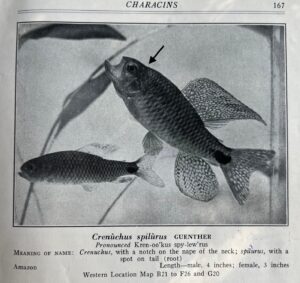 The specific epithet spilurus is easy to figure out. It’s a common name in ichthyology, a combination of the Greek words spílos, mark or spot, and urus, a Latinization of the Greek ourá, tail. It means “spot-tailed,” referring to the round black spot at the caudal peduncle.
The specific epithet spilurus is easy to figure out. It’s a common name in ichthyology, a combination of the Greek words spílos, mark or spot, and urus, a Latinization of the Greek ourá, tail. It means “spot-tailed,” referring to the round black spot at the caudal peduncle.
The generic name Crenuchus, however, has proven difficult. According to FishBase, the name is derived from the Greek krenoychos, the “God of running waters.” Several aquarium websites say it means “guardian of the spring.” Both of these explanations have been copy-pasted and re-posted multiple times. How the name applies to the fish is not explained.
“Krenoychos” appears to be an alternate spelling of the Greek krēnoū́chos (κρηνούχος), which means “ruling over springs.” The word is associated with Poseidon, the Olympian god of the sea. In some ancient cults, Poseidon was worshipped as Krenouchos, who, with the strike of his trident, created springs and thus was the source of fresh (i.e., running) water.
Is “Krenoychos” an allusion to the fish’s habitat? Maybe. But Günther likely described it from a specimen in a jar and probably knew little or nothing from where it was collected other than the Essequibo River of Guyana.
I propose a far less fanciful explanation for Crenuchus: a combination of the Latin crena, meaning notch, and the Medieval Latin nuchus, from nucha, the nape of the neck (from whence the English adjective nuchal derives). William T. Innes reached the same conclusion in his classic Exotic Aquarium Fishes (the book that got me interested in ichthyo-etymology): “with a notch at the nape of neck.”
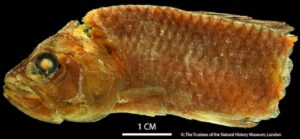 It would be helpful if Günther had mentioned this character in his very brief description, or in a more-detailed description that followed in 1864. He did not. But a museum photograph of the holotype (BMNH 1864.1.21.92) that Günther examined (shown here) does show a separation between the nape and back that may be a damaged remnant of a nuchal notch or indentation.
It would be helpful if Günther had mentioned this character in his very brief description, or in a more-detailed description that followed in 1864. He did not. But a museum photograph of the holotype (BMNH 1864.1.21.92) that Günther examined (shown here) does show a separation between the nape and back that may be a damaged remnant of a nuchal notch or indentation.
What’s more, Innes’ photograph of Crenuchus spilurus (shown above, with an added arrow) clearly shows a small notch in the nape or neck of a nuptial male.
My explanation is still speculation, of course, but at least it’s informed speculation. Nothing about “Krenoychos” seems to fit. And it may be worth noting that Günther was not given to classical allusions and metaphors in the epithets he coined.
There is a loose end I should mention in the interests of full disclosure. In Brown’s Composition of Scientific Words, the –uchus half of Crenuchus is said to be from the Greek echo, meaning “hold, carry.” The “cren-” half of the name is not explained, but krene is Greek for spring (the water body, not the device or season). I translate the name as “spring-bearing,” but that doesn’t make sense. If we translated “cren-” as the Latin crena (“notch”), then “notch-bearing” makes more sense based on what we know about the fish.
30 August
Chiloglanis frodobagginsi Schmidt, Friel, Bart & Pezold 2023
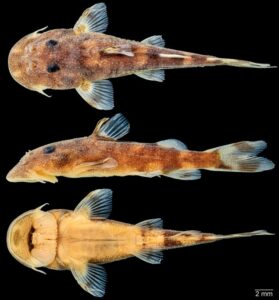
Chiloglanis frodobagginsi. From: Schmidt, R. C., P. H. N. Bragança, J. P. Friel, F. Pezold, D. Tweddle and H. L. Bart Jr. 2023. Two new species of suckermouth catfishes (Mochokidae: Chiloglanis) from Upper Guinean forest streams in West Africa. Ichthyology & Herpetology 111 (3): 376-389.
For the 21 October 2020 “Name of the Week,” we provided a list of fish taxa inspired by characters and places in J. R. R. Tolkien’s Middle Earth legendarium:
Gollum
Durin the Deathless
The Balrogs
Azaghâl, king of the Broadbeam Dwarves
The River Bruinen
Lórien, the realm of the Elves
Galadriel, the elf ruler of Lothlórien (or Lórien)
This week we add another.
Chiloglanis frodobagginsi is a new species catfish from the upper Niger River of Guinea. It is named for Frodo Baggins, a Hobbit of the Shire, who inherits the One Ring from his cousin Bilbo. Aware of the Ring’s malevolent power, Frodo embarks on a long journey to destroy it in the fires of Mount Doom in Mordor. His journey took 185 days, covering a distance of approximately 1800 miles (2897 km).
 Chiloglanis frodobagginsi is, per its describers, another “incredible traveler.” Like Frodo, it is small (reaching 38.1 mm SL). And like Frodo, it too embarked on a long journey — or at least its progenitors did. C. frodobagginsi occurs in the Niger River basin, Guinea. It was previously considered to be a disjunct population of C. micropogon, found in the Congo River basin of Angola and the Democratic Republic of the Congo, roughly 4800 km away. Another seemingly closely related (and undescribed) species similar to C. micropogon is found in the southern Benue drainage and in several small coastal rivers about 3,000 km from the upper Niger River drainage. It is unclear whether these species are descended from a more widespread species, or are the result of dispersal from the Congo River basin into the Niger River drainage, via the Benue River, and then up to the headwaters of the Niger River. If they dispersed, the authors say …
Chiloglanis frodobagginsi is, per its describers, another “incredible traveler.” Like Frodo, it is small (reaching 38.1 mm SL). And like Frodo, it too embarked on a long journey — or at least its progenitors did. C. frodobagginsi occurs in the Niger River basin, Guinea. It was previously considered to be a disjunct population of C. micropogon, found in the Congo River basin of Angola and the Democratic Republic of the Congo, roughly 4800 km away. Another seemingly closely related (and undescribed) species similar to C. micropogon is found in the southern Benue drainage and in several small coastal rivers about 3,000 km from the upper Niger River drainage. It is unclear whether these species are descended from a more widespread species, or are the result of dispersal from the Congo River basin into the Niger River drainage, via the Benue River, and then up to the headwaters of the Niger River. If they dispersed, the authors say …
“This was an incredible journey for such a small and seemingly non-vagile fish.”
A second species of Chiloglanis is described in the same paper. It also has an interesting name. Chiloglanis fortuitus is named for the “fortuitous aspect” of collecting the only known specimen, and its “discovery” in a lot of specimens borrowed by the lead author as he was describing C. tweddlei in 2017.
For an interesting look at the presumed actual fishes of Middle Earth, ichthyologist Philip W. Willink of the Field Museum in Chicago has prepared a handy field guide.
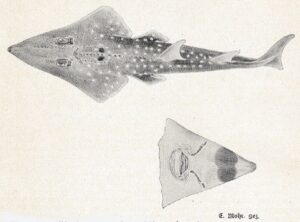
Rhynchobatus luebberti. From: Ehrenbaum, E. 1915. Über Küstenfische von Westafrika, besonders von Kamerun. L. Friederichsen & Co., Hamburg. 1-85 pp. Bottom image shows tip of the head from below (p. 70).
23 August
Rhynchobatus luebberti Ehrenbaum 1914*
(written with Holger Funk)
In recent years, biologists have been reassessing and debating the ethical appropriateness of biological nomina named after people associated with racism, colonialism, imperialism, slavery and other social ills. Some of these biologists have even called for the elimination and replacement of eponyms altogether, a notion rejected in the 3 May 2023 Name of the Week. Yes, eliminating eponyms would effectively “cancel” the names of plants and animals named after proponents of racism. But it would also “cancel” the names of organisms named after people whose careers and reputations were destroyed by institutionalized racism as well. The name of the African Wedgefish Rhynchobatus luebberti (also known as Lubbert’s Wedgefish) is a case in point.

Ernst Ehrenbaum (1861–1942)
Rhynchobatus luebberti is a critically endangered species that occurs in shallow coastal waters in the Eastern Atlantic from Congo to Mauritania. It was described by Ernst Ehrenbaum (1861-1942), a German ichthyologist and oceanographer, in his well-illustrated 1915 book Über Küstenfische von Westafrika, besonders von Kamerun (On coastal fishes from West Africa, especially from Cameroon). With the epithet luebberti, the author honored his friend and colleague Hans Julius Lübbert (1870–1951), a German fisheries inspector and director with whom he had been publishing the periodical Der Fischerbote (The Fishers’ Messenger) in Hamburg since 1910 and the collective volumes Handbuch der Seefischerei Nordeuropas (Manual of Sea Fishing in Northern Europe) since 1926. Ehrenbaum and Lübbert had jointly initiated research into this species of wedgefish by commissioning J.H.C. von Eitzen, captain of a German merchant ship and a drag net expert, to fish the estuary of the Cameroon River for months and to preserve the fishes caught according to precise instructions and to transfer them to Hamburg.

Hans Lübbert (1870–1951)
Lübbert and Ehrenbaum were well-regarded, both nationally and internationally, in various areas of fisheries and oceanography. But their reputations came to an end with the seizure of power by National Socialists (Nazis) beginning in 1933. Since Lübbert and Ehrenbaum came from Jewish families, they were targeted by Nazi officials. It did not matter that their parents had converted to Christianity. In fact, Ehrenbaum (nee Oppenheim) took the name of his stepfather, Major General Eduard Lübbert, a Prussian professional officer, after the death of his biological father and the remarriage of his mother. Because of their Jewish heritage they lost their jobs and their reputations were erased, at first slowly and embellished later with open hostility. For example, at first it was officially said that Ehrenbaum and Lübbert had simply retired when in fact they were forced to resign from their offices. The “official” Nazi explanation for their “retirements” can still be found in German biographical reviews today.
Lübbert and Ehrenbaum were stunned by this development. Fortunately they didn’t end up in a concentration camp or face death like Walther Arndt, a highly respected researcher on sponges and hydrobiology who was executed in 1944 for his critical stance on the Nazi regime. Ehrenbaum died of natural causes in 1942. Lübbert died in 1951, physically unharmed but mentally broken. In 1945, at the age of 75, Lübbert was reappointed as director of fisheries by the British military government to rebuild the Hamburg fisheries system. A small consolation for the injustice he had suffered.
This chapter of German ichthyology was hushed up for a long time and only recently came to light. See Burkard Watermann, “Zum Schicksal einiger Meeresbiologen im Nationalsozialismus” (“On the fate of some marine biologists under National Socialism”), Historisch-Meereskundliches Jahrbuch, vol. 1, Berlin, 1992.
*Shortly after posting this entry, we followed up on a bibliographic loose end and made a surprising discovery. The 1915 monograph in which Ehrenbaum’s description of Rhynchobatus luebberti appeared was serialized the year before in a German fisheries periodical, Der Fischerbote. So the publication date of Rhynchobatus luebberti, long recorded as 1915, is actually 1914.
16 August
Argyripnus scharpfi Prokofiev 2023

From: Prokofiev, A.M. New Species of the Genus Argyripnus (Sternoptychidae) from the Pacific Ocean. J. Ichthyol. 63, 822–827 (2023). https://doi.org/10.1134/S003294522304015X
Some “Name of the Weeks” write themselves.
Yesterday I woke up to news in my email folder that a new species of fish has been named in my honor. Argyripnus scharpfi is a marine hatchetfish (Sternoptychidae) known only from one specimen trawled in April 1971 from the Bonin Ridge in the northwestern part of the Pacific Ocean. It was described by Artem Prokofiev, an ichthyologist with the Russian Academy of Sciences. I’ve known Artem (via email) since the early days of The ETYFish Project. He has been amazingly helpful and generous with his time, scanning obscure Russian fish publications, translating Russian descriptions into English, and tracking down arcane information regarding Russian scientists, locations and vernacular names that would otherwise be impossible to find in the USA. I should be naming a fish after him, not the other way around.
Artem “discovered” the species while sorting through the collection of stomiiform fishes at the Institute of Oceanology of the Russian Academy of Sciences in Moscow. A sample of fishes from the Bonin Ridge included an Argyripnus specimen that did not match any previously described species. Artem examined Pacific Argyripnus specimens at other institutions but did not find any that matched this one. A. scharpfi is most similar to A. atlanticus Maul 1952 but differs in a number of characters, including smaller and more numerous maxillary teeth, and the absence of a noticeable gap between the last photophore of the lateral row and the first photophore of the ventroanal row.
The etymology section of the description reads: “The species is dedicated to Christopher Scharpf, the author of the ETYFish project (www.etyfish.org).”
I’ve been fascinated by fish names ever since opening a copy of William T. Innes’ Exotic Aquarium Fishes sometime in the early 1970s, and discovering that the Black Mollies and Coolie Loaches I kept in a 10-gallon aquarium had formal “scientific” names. I was 10 or 11 at the time. I never could have imagined then that one day a fish would be named after me.
Thank you, Artem, for the unexpected honor.
The fish even looks like me!
The English-language version is behind a paywall. The Russian version (scroll down to page 478) is not:
The genus Argyripnus now contains nine described species, all associated with seamounts of the tropical and subtropical zones of the World Ocean. Proposed by Gilbert & Cramer in 1897, the name is a combination of argyros, white metal (i.e., silver), presumably referring to silvery sides in life, and ipnos, lantern, referring to numerous photophores on the body.
9 August
Fishes and the atom bomb

The Baker Test (24 July 1946), the second of two atomic detonations in the Bikini Atoll, in the initial seconds of the explosion, shrouding its height over the U.S. Navy’s test fleet. The Baker bomb spewed a column of water that hoisted the 10-mile wide, 520-foot tall mushroom cloud. Colorized photo courtesy of National Nuclear Security Administration/Nevada Field Office.
The Christopher Nolan film Oppenheimer has renewed interest in the development of the atom bomb. A year after the detonations in Hiroshima and Nagasaki, the U.S. Department of the Navy continued nuclear weapons testing in the central Pacific … with the help of ichthyologists and other civilian biologists.
Operation Crossroads was a pair of nuclear weapon tests at Bikini Atoll in mid-1946. The purpose of the tests was to investigate the effect of nuclear weapons on warships. Another component of the tests was to study the relative abundance of flora and fauna before and after the explosions. Since fishes represented the group of animals of greatest economic
importance in and around the atoll, great emphasis was placed on them. Statistical studies were made both in 1946 and 1947 to measure the relative abundance of the reef and lagoon fishes, and of the pelagic fishes (e.g., sharks, barracuda, tuna). This latter work was accomplished by commercial fishermen, using trolling methods, under the supervision of John C. Marr and Osgood R. Smith, U. S. Fish and Wildlife Service. The population studies of the lagoon fishes were made in 1946 and 1947 by Vernon E. Brock, director, Division of Fish and Game, Hawaii. Those of the reef fishes were made in 1946 by Dr. Earl S. Herald, then Captain, U.S. Army Medical Corps, and in 1946 and 1947 by Dr. Leonard P. Schultz, curator of fishes, U.S. National Museum, Smithsonian Institution. Altogether, over 50,000 specimens from the northern Marshall Islands and over 15,000 from the southern Marianas Islands were studied.
I have not seen any data about the effects of the explosions and radiation exposure on fish and other marine-life populations. The ichthyological findings, however, were published, in a massive three-volume work edited by Leonard P. Schultz, Fishes of the Marshall and Marianas Islands (1953-1966). In addition to voluminous data on color-pattern variation and distribution, over 110 new fish taxa were described. Several of them were named after members of the Operation Crossroads team:
Hypoatherina barnesi Schultz 1953, a hardyhead or silverside, in honor of oceanographer Clifford A. Barnes, project officer of the U.S.S. Bowditch during Operations Crossroads (studying effects of atomic bombs on Bikini Atoll) in 1946

Synckiropus laddi, holotype. Drawn by Dorothea B. Schultz. From: Schultz, L. P., W. M. Chapman, E. A. Lachner and L. P. Woods. 1960. Fishes of the Marshall and Marianas islands. Vol. 2. Families from Mullidae through Stromateidae. Bulletin of the United States National Museum No. 202, v. 2: i-ix + 1-438, Pls. 75-123.
Synchiropus laddi Schultz 1960, a dragonet, in honor of geologist Harry Stephen Ladd (1899-1982), U.S. Geological Survey, who was at Bikini Atoll in 1946 and again in 1947
Synchiropus morrisoni Schultz 1960, another dragonet, in honor of Joseph Paul Eldred Morrison (1906-1983), associate curator of mollusks, U.S. National Museum, who spent the summers of 1946 and 1947 at Bikini Atoll
Aseraggodes whitakeri Woods 1966, a sole, in honor of biologist Douglas M. Whitaker (1904-1973), Stanford University, who studied the effects of radiation fallout on marine life
Brachaluteres taylori Woods 1966, a filefish, in honor of botanist William Randolph Taylor (1895-1990), University of Michigan; he collected holotype while conducting a botanical survey of Marshall Islands prior to, and immediately after, the atomic bomb tests
The residents of Bikini Atoll, 167 in number, were forcibly relocated before the tests to a nearby atoll. Unable to catch enough fish or gather sufficient food, and largely forgotten by the U.S. government, they suffered from malnutrition and nearly starved to death as nuclear tests continued at Bikini in 1954, 1956 and 1958. In 1970, about 200 residents returned to their home island but were evacuated 10 years later due to health problems from radioactivity in the well water and food supply. Except for divers, a few scientists and a handful of caretakers, Bikini Atoll remains unoccupied today.
J. Robert Oppenheimer did not participate in the testing. In fact, he wrote U.S. President Harry Truman about his objections to it, arguing that mathematical calculations and laboratory tests would produce better data for less money.
 2 August
2 August
Robert E. Jenkins (1940-2023)
Students and enthusiasts of North American freshwater fishes have been dealt a double blow recently. Two months ago, we mourned the passing of David A. Etnier, co-author of The Fishes of Tennessee. Today we mourn the 12 July passing of his colleague Robert E. Jenkins, co-author of The Freshwater Fishes of Virginia. Both books were published the same year (1994). Both are classics of the “Fishes of …” genre of ichthyological literature.
Dr. Jenkins was arguably the world’s leading authority on suckers (Catostomidae). They were the subject of his 800-page Ph.D. thesis at Cornell University. Oddly enough, “Dr. Sucker” — as some colleagues affectionately called him — did not describe any new sucker taxa, but he helped to rediscover one, the so-called of “coelacanth of the Southeast.”
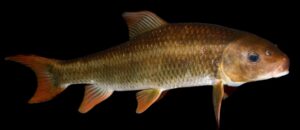
Robust Redhorse, Moxostoma robustum. Photo by Brian Gratwicke.
Edward Drinker Cope described the Robust Redhorse Ptychostomus (now Moxostoma) robustum in 1870 based on a single six-pound specimen collected from the Yadkin River in North Carolina. The specimen was apparently destroyed and by the late 1800s all mention of the fish had dropped from the scientific literature. It was thought to be extinct until the early 1980s, when unidentified specimens were collected from the Savannah and Pee Dee rivers in North Carolina and South Carolina. However, they were not properly identified because the Robust Redhorse name had been misapplied to a related species. In 1991, fishery biologists with the Georgia Department of Natural Resources collected five unrecognized fish from the Oconee River. They sent them to Dr. Jenkins, who untangled the taxonomic knot and determined that the Oconee specimens and the previously collected unknown fish were the lost Robust Redhorse. In effect, the collection of Robust Redhorse from the Oconee River marked the rediscovery of a species that had been lost to science for 122 years—hence giving it the unofficial moniker “coelacanth of the Southeast,” a reference to the famous “fossil fish” discovered off the Comoros Islands in 1938.
In addition to suckers, Dr. Jenkins studied other fishes of the southeastern U.S., and described or co-described eight new species:
Redtail Chub Nocomis effusus Lachner & Jenkins 1967 — Latin for effusive, referring to the numerous breeding tubercles on its body and head
Redspot Chub Nocomis asper Lachner & Jenkins 1971 — Latin for rough, referring to tubercles on the scales on breeding males
Bigmouth Chub Nocomis platyrhynchus Lachner & Jenkins 1971 — platýs (Gr. πλατύς), broad or wide; rhýnchos (Gr. ῥύγχος), snout, referring to its large gape width
Bull Chub Nocomis raneyi Lachner & Jenkins 1971 — in honor of ichthyologist Edward C. Raney (1909-1984), Cornell University, “whose enthusiasm and guidance placed many American students on the professional pathway to ichthyology” (including Jenkins)
Tennessee Dace Chrosomus tennesseensis (Starnes & Jenkins 1988) — –ensis, Latin suffix denoting place: Tennessee River drainage, USA, where it is endemic
Marbled Darter Etheostoma marmorpinnum Blanton & Jenkins 2008 — marmor, from marmoratus (L.), marbled; pinnum, Neo-Latin adjective (neuter) of pinna (L.), fin, referring to the distinct marbled pattern of second dorsal fin of breeding males
Duskytail Darter Etheostoma percnurum Jenkins 1994 — perknós (Gr. περκνός), dark or dusky, and urum, tailed, from ourá (Gr. οὐρά), tail, referring to reduced barring on tail, which contrasts “markedly” with patterns of other members of the E. flabellare (“fantail darter”) group
In 1980, Jenkins and David Etnier collaborated on the description of the Pygmy Madtom Noturus stanauli, coining a fascinating name based on the Cherokee words oostaunali (a shoal area in a river) and tsulistanauli (catfish), referring to the fish’s occurrence over shoals with gravel substrate.
One fish has been named in Dr. Jenkins’ honor: Conasauga Logperch Percina jenkinsi Thompson 1985, for his work with eastern North American fishes, particularly with the genus Percina.
Dr. Jenkins left behind a number of manuscripts and lots of unpublished data on sucker systematics and life histories. Jonathan W. Armbruster of Auburn University is shepherding their completion and publication. It’s likely that Jenkins will receive one or more posthumous bylines in the near future and will perhaps have one of his beloved suckers named after him.
In addition to his ichthyological work, Dr. Jenkins was an accomplished marathoner, cycling enthusiast, aquarist, and fan of Pink Floyd and The Grateful Dead. He penned this brief autobiography for the North American Native Fishes Association.
The photograph of Dr. Jenkins “at work” in the field is alone worth the click through.
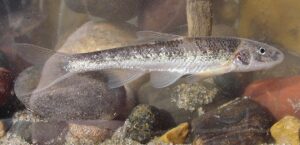
Macrhybopsis gelida. Photo © Dave Ostendorf, Missouri Department of Conservation
26 July
Macrhybopsis gelida (Girard 1856)
It was a name I had given up on years ago. The ETYFish entry reads “frozen or stiff, allusion not explained nor evident.” Last week I reopened the gelida “case file” and a possible explanation emerged.
Macrhybopsis gelida, Sturgeon Chub, is a slender minnow that occurs in the muddy, murky waters of the Mississippi and Missouri Rivers along with several major tributaries. Its historic range included 13 states from Montana and North Dakota south to Arkansas and Tennessee. It was described by ichthyologist Charles Girard (1822–1895) as Gobio gelidus in 1856, who thought it was related to the gudgeons (Gobio) of Europe. (The adjective is spelled gelidus in Gobio, a masculine genus, and gelida in Macrhybopsis, which is feminine.)
Girard was a Frenchman who studied under the famous zoologist-geologist Louis Agassiz in Switzerland. He accompanied his teacher when Agassiz moved to the United States in 1846. Girard became a naturalized U.S. citizen in 1854 while he was working at the Smithsonian Institution sorting through and describing western U.S. fishes collected during the U.S. government’s Mexican-boundary and Pacific-railroad surveys. One of them was Gobio gelida, collected in 1853 by Army surgeon-naturalist George Suckley (1830–1869) from the Milk River, an affluent of the upper Missouri River in upstate Montana, not far from Saskatchewan, Canada.
I got the “frozen or stiff” explanation of gelida from Etnier and Starnes’ Fishes of Tennessee (1994) and Pflieger’s Fishes of Missouri (2nd ed., 1997). Neither book explained what the adjective was referring to. I wondered if there was something frozen or stiff about the fish. But I rejected that possibility when I read Girard’s more-detailed explanation of the species, published in 1858. He described it as “most graceful in its general appearance; its well developed vertical fins must contribute a great deal towards rendering its movements swift.” That does not sound like frozen or stiff fish to me. (Note: The common name Sturgeon Chub, proposed sometime after Girard’s description, probably refers to its ventral mouth and long snout, which overhangs the mouth, somewhat like the snout of a sturgeon.)
I double-checked the meaning of gelidus in a Latin dictionary and found that the adjective can also mean icy cold, very cold, icy or frosty. This suggested to me that Girard was referring to the habitat or geographic location of the fish and not to any morphological character of the fish itself. Armed with an expanded definition of gelidus, I returned to Girard’s original description to see if he mentioned climate or weather conditions. He did not. But I found something even more intriguing …
In addition to Gobio gelidus, Girard described two other new species of Gobio in the same paper: Gobio (now Macrhybopsis) aestivalis from Río San Juan, near Cadereyta, Nuevo León, Mexico, and G. vernalis (a junior synonym of Macrhybopsis storeriana) from the Arkansas River near Ft. Smith, Arkansas.
Note that Girard appears to be alluding to three different seasons — or perhaps weather conditions — in the names. “Aestivalis” is Latin for “summer-like” or “of the summer.” It’s used for the most southern of the three species. “Gelidus,” meaning cold or very cold, is applied to the species described from northern Montana, where the average surface temperature in the winter ranges from -2°C to -11°C. “Vernalis” is Latin for “of the spring.” It’s applied to the species described from a latitude between the other two.
Was Girard alluding to the times of year when the three species spawn? I don’t think so. Girard described them from museum specimens collected some years before. If the collectors observed spawning in the wild, then that data was not recorded or preserved. Macrhybopsis species spawn from late April to August, depending on the species.
Was Girard alluding to the times of year the holotypes were collected? Maybe. But once again, that data does not exist.
The best guess is this: The specific epithet of Macrhybopsis gelida alludes to the considerably colder environment of the Milk River of northern Montana as compared with the subtropical type locality of M. vernalis (=storeriana) and the tropical wet-and-dry climate of Cadereyta, Mexico. There’s no way to prove this, of course. But it’s fun to speculate.
19 July
Lönnberg, Lonnberg, Loennberg and Lonberg
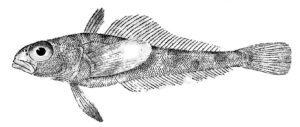
Pseudotrematomus loennbergii. From: Regan, C. T. 1913. The Antarctic fishes of the Scottish National Antarctic Expedition. Transactions of the Royal Society of Edinburgh v. 49 (pt 2, no. 2): 229-292, Pls. 1-11.
In 1913, two new species of notothenioid fishes were named in honor Swedish zoologist Einar Lönnberg (1865–1942): Trematomus (now Pseudotrematomus) loennbergii Regan 1913 and Artedidraco (now Neodraco) lonnbergi Roule 1913. Ignore the “-ii” and “-i” terminal endings for now (I’ll explain them at the end). Instead, notice that the spellings of Lönnberg’s name in the trivial epithets differ by the presence or absence of one letter: Loennberg vs. Lonnberg. That wasn’t always the case. In fact, both names were spelled loennbergi/ii until I recommended that Roule’s “loennbergi” be emended to “lonnbergi” last year. The editors of Eschmeyer’s Catalog of Fishes (ECoF) agreed to the change. Here’s why.
Under the rules of zoological nomenclature, diacritical marks — any mark, shape, stroke, or sign added or attached to a letter for a particular reason — are not allowed in the orthography of a zoological nomen. Per ICZN Art. 32.5.2.1, diacritic vocals (ä, ö and ü) in nomina published before 1985 need to be emended to ae, oe or ue, respectively.
The tricky thing is, this rule only applies to names of German origin. According to Stefan Koerber (2009, Zootaxa 2201), Einar Lönnberg’s name is Swedish, so changing the “ö” to “oe” is not required. Simply spelling the name “lonnbergi” will suffice. But spelling the name “loennbergi” is not forbidden either. The “umlaut-to-ae/oe/ue” rule is only evoked when a German name or word is originally spelled with the umlaut. That’s why fishes named after the famous ichthyologist Albert Günther (who was German) that were originally spelled “güntheri” are now spelled “guentheri” today.
When ichthyologist C. Tate Regan (1878–1943) of the Natural History Museum (London) named Trematomus (now Pseudotrematomus) loennbergii in 1913, he did not use the umlaut in his orthography. If he had, then changing “lönnbergii” to “lonnbergii” would have been mandatory. Instead, Regan opted to Latinize the “ö” to “oe.” His spelling is considered intentional and therefore is retained. (Regan honored Lönnberg for his “kindness” in sending the holotype and other specimens.)
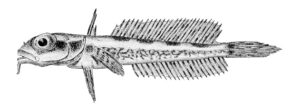
Neodraco lonnbergi. From: Roule, L. 1913. Deuxième expédition antarctique française (1908-1910) commande par le Dr. Jean Charcot. Sciences naturelles: documents scientifiques. Poissons. Masson et Cie, Éditeurs, Paris. 1-24, Pls. 1-4.
The spelling of Artedidraco (now Neodraco) lonnbergi, described by French ichthyologist Louis Roule (1861–1942), has a more complicated history. Roule described the species twice in 1913. In “Deuxième expédition antarctique française (1908-1910) commande par le Dr. Jean Charcot,” an expedition monograph, he spelled the name “lonbergi” but clearly identified “Lönnberg” in his dedication. The “lonbergi” spelling, missing an “n,” is considered a printer’s error or typo since there is evidence within the publication (per ICZN 32.5.1) that another spelling was intended. Therefore, “lonbergi” has been corrected to “lonnbergi.” (If Roule had not mentioned Lönnberg, the name’s spelling may still be “lonbergi” today.)
Later that year, Roule’s description was republished in a journal, Bulletin du Muséum national d’histoire naturelle. This time he spelled the name with the umlaut: “lönnbergi.” It seems most subsequent ichthyologists overlooked the first, harder-to-find, description and referenced only the second one. It also seems that subsequent ichthyologists took it upon themselves to “correct” the spelling of “lönnbergi” to “loennbergi” believing that Lönnberg is a German name, or that “ö” must always be rendered as “oe,” or perhaps both. That explains why many references — including earlier versions of ECoF and the 2022 phylogenetic study Antarctic plunderfishes by Parker and Near — spell the name “loennbergi,” an unnecessary emendation. Whether you date the name to Roule 1913a or Roule 1913b, the result is the same: the name should be spelled “lonnbergi.”
But why the different “-ii” and “-i” endings? Some early taxonomists, still beholden to Latin as the official language of science, Latinized their dedicatees’ names. For example, the popular Coolie (or Kuhli) Loach of tropical aquaria, Pangio kuhlii (Valenciennes 1846), was named in memory of Heinrich Kuhl (1797–1821), who died while collecting plants and animals in Java, including this loach. Valenciennes Latinized Kuhl to Kuhlius. The genitive spelling for Latinized names like Kuhlius can take either the –i or –ii ending, but –ii is more common. Regan apparently Latinized “Lönnberg” to “Loennbergius,” hence the –ii of loenbergii. (Nowadays, at least among fishes, the –ii genitive is rarely proposed.)
12 July
Salariopsis renatorum Yoğurtçuoğlu, Kaya, Atalay, Ekmekçi & Freyhof 2023

Salariopsis renatorum, holotype, 61 mm SL, Aksu at Pazarcık, Türkiye. From: Yoğurtçuoğlu, B., C. Kaya, M. A. Atalay, F. G. Ekmekçi and J. Freyhof. 2023. Two new freshwater blennies from the eastern Mediterranean basin (Teleostei: Blenniidae). Zootaxa 5311 (no. 1): 85-104.
On 22 October, 2022, Turkish ichthyologist Baran Yoğurtçuoğlu and his team were collecting specimens of Salariopsis, a genus of freshwater combtooth blennies, in Pazarcık, a town in the southern part of Kahramanmaraş Province in Türkiye (Turkey). Little did they know that 15 weeks later Pazarcık would be the epicenter of a devastating 7.8-magnitude earthquake on 6 February 2023. This quake triggered a second earthquake, magnitude 7.5, a few hours later along a different fault line further north. Then, on 20 February, a third powerful quake, a 6.4-magnitude aftershock, registered in the city of Antakya.
During this expedition, Dr. Yoğurtçuoğlu and his team discovered a new species at Pazarcık. In fact, they experienced the earthquake while finalizing the species’ description. They named it Salariopsis renatorum. Their explanation for the name is as follows:
“Freely formed on “renātus”, perfect participle of the Latin verb “renāscor” signifying rejuvenation, renewal, or rebirth. The type locality of the species is situated in Pazarcık, which acted as the central location for the devastating earthquakes that impacted several Turkish cities, along with some Syrian regions, on February 6, 2023. These seismic events led to the loss of over 60,000 lives with a significant number of individuals injured and a substantial amount of structural damage. The species name is emblematic of the concepts of regeneration and revival, honouring the hope and resilience demonstrated by the communities impacted by these calamitous events. Additionally, the name is dedicated in memory of Gözde Bayırlı, a cousin of BY, as well as her family and all others who lost their lives during this tragic earthquake.”
According to British Red Cross, close to 18 million Turkish and Syrian people have been impacted by the disaster. In addition to over 60,000 fatalities, nearly 130,000 were injured. Millions have been displaced from their homes. The United Nations Children’s Fund estimates about four million children are still in need of humanitarian assistance and 1.6 million are living in tents or other temporary shelters, some without access to water.
Recovery from the earthquakes is expected to take years.
In addition to Salariopsis renatorum, Dr. Yoğurtçuoğlu and his team have described a second new species of the genus, Salariopsis burcuae. Its name is much happier:
“The species is named after Burcu Yoğurtçuoğlu, the wife of the first author, in gratitude for her profound inspiration, as well as admirable patience and support towards her husband’s endless travels to explore fishes. Her understanding, despite the occasional unintentional neglect due to her husband’s tireless dedication to his work, have been invaluable to his achievements in ichthyology.”
5 July
The first-ever “petonym”?
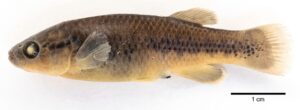
Profundulus rei, holotype, 44.4 mm SL. From: Calixto-Rojas, M., A. Lira-Noriega, M. Rubio-Godoy, G. Pérez-Ponce de León, and C. D. Pinacho-Pinacho. 2023. Delimitation and species discovery in the Profundulidae fish family: Using genetic, environmental and morphologic data to address taxonomic uncertainty. Molecular Phylogenetics and Evolution 186: 107856. https://doi.org/10.1016/j.ympev.2023.107856.
An eponym is a name or noun formed after a person. In biological nomenclature, eponyms honor people important to the person penning the description. A colleague, collector, mentor, loved one, and so forth.
This may be the first time a fish has been named after a … pet.
Profundulus rei Calixto-Rojas, Lira-Noriega, Rubio-Godoy, Pérez-Ponce de Léon & Pinacho-Pinacho 2023 is a new species of Middle American Killifish (Profundulidae). It’s restricted to one subbasin within the Ometepec River basin between the states of Guerrero and Oaxaca in Mexico.
The specific epithet “rei” refers to the first author’s pet cat Rei, his “companion for 11 years, during which his academic formation took place (BSc, MSc and almost all PhD), and was his constant attendant while measuring all the fish specimens for this work.” The cat’s name was inspired by the fictional character Rei Ayanami from the Japanese animation series Neon Genesis Evangelion.
I can’t speak for other taxonomic groups, but I am pretty sure this is the only fish named after a pet. Strictly speaking, such a name is not really an eponym because it does not honor a human. Perhaps we should call it a “syntrophonym,” based on σύντροφον (sýntrophon), a Greek word for a family or house pet. Or perhaps the less cumbersome and decidedly more cuddly “petonym.”
Here’s something else about the description of this species I’ve never seen before. In the acknowledgments section of their paper, the authors thank several people and institutions for their contributions to the study. And then they recognize another contributor:
“Special thanks to the fish that gave their lives to carry out this study.”
28 June
Astronesthes Richardson 1845
Go to the Wikipedia entry for Astronesthes and the heading reads “Stareater (fish).” The entry explains that “Snaggletooths or stareaters are any of a number of small, deep-sea stomiid fish in the genus Astronesthes. They possess a bioluminescent red chin barbel that the fish use as a lure to attract small prey into striking distance.”
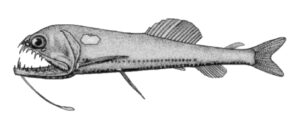
Astronesthes nigra. Illustration by Susan Laurie Bourque. From: Coad, B. W., H. Waszczuk and I. Labignan. 1995. Encyclopedia of Canadian Fishes. Canadian Museum of Nature and the Canadian Sportfishes Productions Inc. 928 p. + 16 color plates. Courtesy: FishBase.
The unusual name “Stareater” is not explained. That’s because “Stareater” is a mistranslation of Astronesthes dating to Jordan & Evermann’s seminal four-volume Fishes of North and Middle America (1896–1900). In fact, Jordan & Evermann tapped Walter Miller (1864–1949), a linguist and classical scholar, to review and correct the name etymologies in the book. Unfortunately, they dropped the ball on this one. At least initially.
In volume one (1896, p. 586), Jordan & Evermann provided this etymology: “ἄστρον, star (starfish); ἐσθίω, to eat.” They did not explain how a mesopelagic fish manages to eat creatures that crawl on the seabed.
Two years later, in volume three (p. 2826), Jordan & Evermann corrected their translation: “Astronesthes is from ἄστρον, star; ἐσθής, vestment.” They got it right this time. Indeed, Scottish surgeon-naturalist John Richardson (1787–1865) clearly spelled it out in his 1845 description of the genus, when he translated the Greek name into Latin: stella (star) + vestimentum (vestment). But Jordan & Evermann’s correction was buried in the “Addenda” section of their publication and apparently was overlooked. At some point, “stareater” entered the ichthyolexicon as a common name for the genus Astronesthes even though the name makes no sense whatsoever.
Okay, but what does “star vestment” mean? Although Richardson did not explicitly explain why he coined the name, he left plenty of clues in his description of the genus and its type species Astronesthes nigra. Richardson said the skin of the fish was “thickly studded” with white “microscopical papillæ.” He also described ~22 luminous spots, “conspicuous to the naked eye, and very ornamental,” between the chin and the ventral fin. On the black skin of the fish (hence the trivial epithet nigra), these papillae and/or spots can be said to appear like stars in a black sky. Put another way, Astronesthes means “clothed in stars.”
Jordan & Evermann may not have been the first ichthyologists to surmise that Astronesthes meant “stareater.” In 1864, Albert Günther changed the spelling of the trivial epithet from nigra (feminine) to niger (masculine) without explanation. This change would have been sense if Günther believed that Astronesthes was derived from the masculine esthíō (“to eat”) instead of the feminine esthḗs (clothing). The incorrect spelling “Astronesthes niger” is still in use today but Eschmeyer’s Catalog of Fishes (ECoF) recommends the original (and correct) spelling, Astronesthes nigra.
Fourteen other Astronesthes species with adjectival names have been described since A. nigra, all treated as masculine by their authors. ECoF recommends emending their spellings from masculine to feminine as well:
Astronesthes atlanticus Parin & Borodulina 1996 > atlantica
Astronesthes barbatus Kner 1860 > barbata
Astronesthes bilobatus Parin & Borodulina 1996 > bilobata
Astronesthes cyaneus (Brauer 1902) > cyanea
Astronesthes decoratus Parin & Borodulina 2002 > decorata
Astronesthes illuminatus Parin, Borodulina & Hulley 1999 > illuminata
Astronesthes indicus Brauer 1902 > indica
Astronesthes indopacificus Parin & Borodulina 1997 > indopacifica
Astronesthes lamellosus Goodyear & Gibbs 1970 > lamellosa
Astronesthes lucifer Gilbert 1905 > lucifera (see footnote 1, below)
Astronesthes quasiindicus Parin & Borodulina 1996 > quasiindica
Astronesthes spatulifer Gibbs & McKinney 1988 > spatulifera
Astronesthes splendidus Brauer 1902 > splendida
Astronesthes trifibulatus Gibbs, Amaoka & Haruka 1984 > trifibulata
You see, knowing the correct etymology of a name does have consequences!
Footnote 1: If Gilbert had named Astronesthes lucifer after the Prince of Darkness (a noun), its spelling would remain unchanged. But it seems more likely that the name is a combination of lux, light, and fero, to bear (an adjective), referring to the numerous photophores on its body. Therefore, emendation to lucifera is recommended. (A. spatulifer/spatulifera is a similarly constructed name.)
Footnote 2: Astronesthes similus Parr 1927 is not included in the above list although its name looks like an adjective. Why? Because it’s not a Latin word. I suspect it’s a misspelling of similis, Latin for like or resembling, as the species was described as “very closely related” to A. lucifera. Since its etymology is unclear (Parr did not provide an explanation), the name is treated as an indeclinable noun.
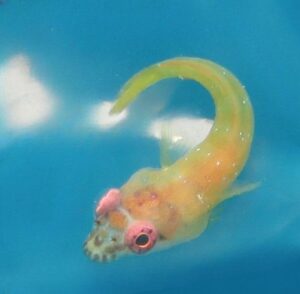
Diplecogaster roseiocula, holotype, 14.7 mm SL, live coloration immediately after collection. Photograph by Peter Wirtz. From: Fricke, R. and P. Wirtz. 2023. Diplecogaster roseioculus, a new species of clingfish (Teleostei: Gobiesocidae) from São Tomé Island, eastern Atlantic Ocean. Taxa (journal of taxonomy and systematics) v. 1: 1-9.
21 June
Diplecogaster roseiocula Fricke & Wirtz 2023
Of the 300-plus new fish species described every year, very few of them make me say, “Wow! Look at that!” This one did.
The Pink-eye Clingfish Diplecogaster roseiocula is a diminutive fish, no more than 16 mm TL, described from a single specimen from São Tomé Island, 240 km west of Gabon in the eastern Atlantic Ocean. It was discovered by the second author, Peter Wirtz (Universidade do Algarve, Portugal), while SCUBA diving at the island in January of this year.
Clingfishes (Gobiesocidae) are named for the adhesive disk formed by their pelvic fins. They inhabit hard substrates, usually on rocky bottom or in coral reefs, mostly in shallow waters. This species was collected at a depth of 40 m (deep for a clingfish), at an isolated rock (ca. 8 m long, 5 m wide) on sandy bottom, in a small crevice.
Clearly, the most remarkable aspect of this tiny fish is its bright pink eyes, for which it is named. Unfortunately, the authors committed two errors in their formation of the name, which they originally spelled as “roseioculus,” not “roseiocula.” As they explained it:
Etymology: Roseus (Latin) means rose, oculus (Latin) means eye. The name refers to the pink eyes of the new species. It is an adjective with a masculine ending when classified in the genus Diplecogaster.
The first error is that the name is a noun (pink-eye), not an adjective (pink-eyed). The proper adjectival form of the Latin noun oculus in classical Latin would be ocularius or oculatus, and in late ancient Latin ocularis.
The second error is that the genus Diplecogaster is feminine, not masculine. So, if the combination noun “roseioculus” were to be treated as an adjective, it should be spelled “roseiocula” when placed in Diplecogaster. Eschmeyer’s Catalog of Fishes — of which the first author, Ronald Fricke, is one of the editors — has adopted the revised spelling.
I jokingly suggested to Dr. Fricke that he should have named the fish “Diplecogaster conjunctivitis” after the medical condition popularly known as pink eye. He said the fish’s eyes are too beautiful to be given the name of a disease. Okay, I can’t disagree with that. But it would have been a funny name!
14 June
Two additions to the ETYFish bookshelf
Two books were published recently that should be of interest to ETYFish readers:
- Ichthyopedia: A Biographical Dictionary of Ichthyologists by Theodore W. Pietsch and William D. Anderson, Jr. American Philosophical Society. 301 pp. $65.
- Eponym Dictionary of Fishes by Bo Beolens, Michael Grayson and Michael Watkins. Whittles Publishing. 1472 pp. £65.
The books are similar in that they provide brief biographical sketches of people involved with fishes: people who contributed to ichthyology in one book and people for whom fishes have been named in the other.
 Ichthyopedia includes individuals who have added to the study of ichthyology, from Aristotle through the 21st century, be it through research, publications, significant collections, illustrations, exploratory expeditions, and other means. Only deceased people are included. The book contains about 1,500 entries with 254 black-and-white thumbnail portraits.
Ichthyopedia includes individuals who have added to the study of ichthyology, from Aristotle through the 21st century, be it through research, publications, significant collections, illustrations, exploratory expeditions, and other means. Only deceased people are included. The book contains about 1,500 entries with 254 black-and-white thumbnail portraits.
The Eponym Dictionary of Fishes includes anyone for whom a fish genus or species has been named, representing a diverse assemblage of scientists, explorers, collectors, mentors, benefactors, philanthropists, politicians, family members, and favorite writers, composers, artists, and so on. There are nearly 6,500 entries. No illustrations.
The ETYFish Project served as a behind-the-scenes contributor to the Eponym Dictionary. I shared references and information with the authors and they shared biographical data with me. ETYFish is warmly acknowledged in the introduction.
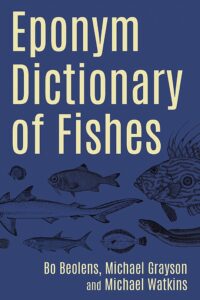 There is, of course, considerable overlap in the two books’ coverage since many people who contributed to ichthyology also had fishes named after them. Take, for example, the entries for David Starr Jordan. Not only was he the most prominent American ichthyologist of the late 19th and early 20th centuries, but more fish taxa have been named after him (36) than any other person (full list below). The differences between the two books’ entries for Jordan illustrate the differences in their styles.
There is, of course, considerable overlap in the two books’ coverage since many people who contributed to ichthyology also had fishes named after them. Take, for example, the entries for David Starr Jordan. Not only was he the most prominent American ichthyologist of the late 19th and early 20th centuries, but more fish taxa have been named after him (36) than any other person (full list below). The differences between the two books’ entries for Jordan illustrate the differences in their styles.
The Ichthyopedia for Jordan, at 211 words, summarizes the highlights of his life and career: birth, education, employment, peace activism, conservation work, and his voluminous contributions to ichthyology.
At 323 words, the Eponym entry covers the same ground, but also includes some of the controversial aspects of Jordan’s life, including his support of eugenics and compulsory sterilization, and his mysterious role in the strychnine poisoning and death of Jane Stanford, President of the Stanford University board of trustees.
A criticism I have of Ichthyopedia is that it largely eschews anything disreputable or controversial about the lives of the people it covers. Another example: In the entry for American zoologist Robert Wilson Shufeldt (1850-1934), Ichthyopedia skips over the fact that Shufeldt’s most significant contributions were not in the field of zoology, but in the social and scientific justifications of racism and white supremacy (see NOTW, 26 July 2017). The Eponym Dictionary does not dwell on this aspect of Shufeldt’s life but at least touches upon it.
The Eponym Dictionary includes a list of the fish taxa named after Jordan. That list is reproduced here. I updated the nomenclature and added one overlooked species (Conger jordani):
- Flagfish genus Jordanella Goode & Bean 1879
- Sculpin genus Jordania Starks 1895
- Eelpout genus Davidijordania Popov 1931
- Petrale Sole Eopsetta jordani Lockington 1879
- Yellow Irish Lord Hemilepidotus jordani Bean 1881
- Gulf Grouper Mycteroperca jordani Jenkins & Evermann 1889
- Northern Ronquil Ronquilus jordani Gilbert 1889
- Greenbreast Darter Etheostoma jordani Gilbert 1891
- Mesa Silverside Chirostoma jordani Woolman 1894
- Plains Sucker Pantosteus jordani Evermann 1895
- Fanfin Angler Caulophryne jordani Goode & Bean 1896
- Shortbelly Rockfish Sebastes jordani Gilbert 1896
- Jordan’s Damsel Teixeirichthys jordani Rutter 1897
- Whipper Snapper Lutjanus jordani Gilbert 1898
- Viviparous Brotula sp.Diplacanthopoma jordani Garman 1899
- Mimic Triplefin Enneanectes jordani Evermann & Marsh 1899
- Poacher sp. Agonomalus jordani Jordan & Starks 1904
- Flame Wrasse Cirrhilabrus jordani Snyder 1904
- Jordan’s Sculpin Triglops jordani (Schmidt 1904)
- Jordan’s Chimaera Chimaera jordani Tanaka 1905
- Jordan’s Triangular Batfish Malthopsis jordani Gilbert 1905
- Rattail sp. Coelorinchus jordani Smith & Pope 1906
- Shortjaw Eelpout Lycenchelys jordani Evermann & Goldsborough 1907
- Jordan’s Tuskfish Choerodon jordani Snyder 1908
- Surfperch sp. Ditrema jordani Franz 1910
- Brokenline Lanternfish Lampanyctus jordani Gilbert 1913
- Cod Icefish sp. Patagonotothen jordani Thompson 1916
- Smooth Lumpfish Cyclopteropsis jordani Soldatov 1929
- Cherry Snailfish Allocareproctus jordani Burke 1930
- Ratmouth Barbel Ptychidio jordani Myers 1930
- Eelpout sp. Davidijordania jordaniana Schmidt 1936
- Icefish sp. Neosalanx jordani Wakiya & Takahasi 1937
- Jordan’s Cod Gadella jordani Böhlke & Mead 1951
- White River Chub Gila jordani Tanner 1950
- Conger Eel sp. Conger jordani Kanazawa 1958
- Southern Red Tabira Bitterling Acheilognathus tabira jordani Arai, Fujikawa & Nagata 2007
Please note that Jordan did not name Agonomalus jordani Jordan & Starks 1904 (no. 17) after himself. The convoluted nomenclatural story behind that name is recounted in NOTW 3 June 2020.
7 June
Horns up!

Melanostomias dio, here and detail of terminal bulb shown below. From: Villarins, B. V., L. G. Fischer, A. M. Prokofiev and M. M. Mincarone. A new species of the dragonfish genus Melanostomias (Stomiidae: Melanostomiinae) from the western Tropical Atlantic. Ichthyology & Herpetology 111 (2): 254–263.
There are fish taxa named after Bach. Vivaldi. John Lennon. Frank Zappa. Led Zeppelin. Earl Scruggs. Enya. And other composers, singers and musicians. Here’s the latest entry to the ichthyomusical eponymicon: Melanostomias dio Villarins, Fischer, Prokofiev & Mincarone 2023

 M. dio is a scaleless black dragonfish (family Stomiidae) known only from its type locality, the northern Fernando de Noronha Archipelago of Brazil in the western Tropical Atlantic. The holotype and only known specimen (180 mm SL) was collected via mid-water trawl in April 2017 at a depth of 440 m. Within the genus, there is very little variation in body shape. Many species are recognized primarily by the structure of their chin barbel alone. M. dio is no exception. The chin barbel of M. dio ends in a bulb with two opposite slender terminal appendages. For this reason, the authors named the species in honor of the late Ronald James Padavona (1942-2010), professionally known as Ronnie James Dio.
M. dio is a scaleless black dragonfish (family Stomiidae) known only from its type locality, the northern Fernando de Noronha Archipelago of Brazil in the western Tropical Atlantic. The holotype and only known specimen (180 mm SL) was collected via mid-water trawl in April 2017 at a depth of 440 m. Within the genus, there is very little variation in body shape. Many species are recognized primarily by the structure of their chin barbel alone. M. dio is no exception. The chin barbel of M. dio ends in a bulb with two opposite slender terminal appendages. For this reason, the authors named the species in honor of the late Ronald James Padavona (1942-2010), professionally known as Ronnie James Dio.
Ronnie James Dio was an American heavy metal vocalist who fronted and founded numerous bands throughout his career, including Elf, Rainbow, Black Sabbath, Dio and Heaven & Hell. He popularized the hand gesture commonly referred to as “horns up.” As you can see, the fish’s terminal bulb and the hand gesture are indeed similar.
For originality and relevance, we give the “horns up” eponym a big thumbs up.
31 May
David A. Etnier (1938-2023)
In 1972, aquatic biologist David A. Etnier hand-cupped a fish while snorkeling in the Little Tennessee River of Tennessee. It turned out to be a new species, which he described as Percina tanasi, the Snail Darter, named for a village on the Little Tennessee that served as the Cherokee Nation capital and the origin of the name Tennessee. (The common name refers to its diet of snails.) Three years later Dr. Etnier ended up in court, defending the fish’s habitat from the Tennessee Valley Authority (TVA) and its proposed Tellico Dam. The Snail Darter had become the “poster fish” of the Endangered Species Act (ESA), which had recently become law.
“Dr. Etnier, what is the size of this snail darter fish?” a TVA lawyer asked in U.S. District Court in Knoxville, Tennessee. His tone implied that such a small fish (55-90 mm) was not worthy of such a big fuss.
“It’s about three times the size of the Devils Hole Pupfish,” Etnier replied. The Devils Hole Pupfish Cyprinidon diabolis had recently won protection against developers in Nevada.
The fate of the Snail Darter eventually made its way to the U.S. Supreme Court. The court ruled in favor of the fish in 1978. But dam-friendly lawmakers angry that a small fish stopped their dam formed a special advisory group disdainfully called “The God Squad,” which had the power to decide the fate of a species when serious “progress” was at stake. Surprisingly, the God Squad ruled against building the dam. The Snail Darter won this round as well — or so it seemed. Shifty lawmakers snuck a rider onto a bill exempting Tellico Dam from all federal law. The dam was built anyway and the original habitat of the Snail Darter was wiped out, but not before TVA biologists removed 316 specimens and introduced them to the nearby Hiwassee River.
In 1980, Dr. Etnier was seining in South Chickamauga Creek in downtown Chattanooga when a familiar looking fish caught his eye. “Well, I’ll be a son of a bitch,” he said. A second native population of the snail darter was found. Eventually, other populations were discovered, and the fish was downlisted from endangered to threatened.

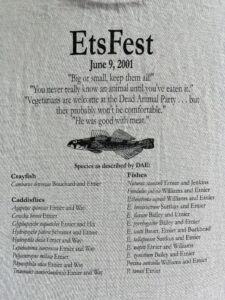 David A. Etnier passed away peacefully on May 17, 2023 in Knoxville, Tennessee, at the age of 84. Although best known for the Snail Darter, his 60-year career was full of accomplishment and accolade. He taught for 35 years at the University of Tennessee’s Department of Ecology and Evolutionary Biology, mentoring over 65 graduate students, who lovingly called him “Ets.” During that time, “Ets” authored and co-authored over 70 publications, including (with Wayne Starnes), The Fishes of Tennessee, one of the best “Fishes of …” books ever. He also formally described and named 22 new animal species, and had nine newly discovered species named in his honor by colleagues. I won’t list them all here. Instead, see the accompanying photographs, which show the back and front of my well-worn “ETS Fest” t-shirt from June 2001. (A few species since 2001 are not on the shirt.)
David A. Etnier passed away peacefully on May 17, 2023 in Knoxville, Tennessee, at the age of 84. Although best known for the Snail Darter, his 60-year career was full of accomplishment and accolade. He taught for 35 years at the University of Tennessee’s Department of Ecology and Evolutionary Biology, mentoring over 65 graduate students, who lovingly called him “Ets.” During that time, “Ets” authored and co-authored over 70 publications, including (with Wayne Starnes), The Fishes of Tennessee, one of the best “Fishes of …” books ever. He also formally described and named 22 new animal species, and had nine newly discovered species named in his honor by colleagues. I won’t list them all here. Instead, see the accompanying photographs, which show the back and front of my well-worn “ETS Fest” t-shirt from June 2001. (A few species since 2001 are not on the shirt.)
In October 2022, the Snail Darter — the “poster fish” of the Endangered Species Act — was removed from the Federal List of Threatened and Endangered Wildlife. At the delisting ceremony, Dr. Etnier was awarded the U.S. Fish and Wildlife Service Lifetime Achievement Award for his career-long achievements in aquatic biology and his enduring legacy through the work of his students and other conservationists he inspired. Dr. Etnier is featured at the two-minute mark in the video featured above.
24 May
Beware the Gourd Head
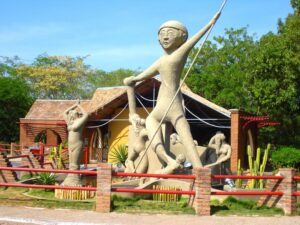 If you live along the rio Parnaíba in Piauí State, Brazil, and have a virginal daughter named Maria, you may want to take extra precautions to keep her safe. Because Crispim, aka Cabeça de Cuia, aka Gourd Head, wants to eat her.
If you live along the rio Parnaíba in Piauí State, Brazil, and have a virginal daughter named Maria, you may want to take extra precautions to keep her safe. Because Crispim, aka Cabeça de Cuia, aka Gourd Head, wants to eat her.
According to local legend, Crispim was a young fisherman who lived on the banks of the rio Parnaíba. His mother was his only family. They were poor, and since fish were scarce in the flooded forests of the rainy season, they were hungry as well. One day Crispim left early to fish but caught nothing. When he returned home, his mother offered him a bowl of thin soup, water mixed with flour, and a single meatless ox bone for flavor. Tired and frustrated from a day of unsuccessful fishing, Crispim threw the bone at his mother, hitting her in the head and killing her. Before dying, she cast a curse upon her son, turning him into a monster. As Crispim runs away, his head begins to grow, taking on the shape of cuia, a hard-shelled fruit with a gourd-like shape. Hence the name Cabeça de Cuia, or Gourd Head.

Parotocinclus cabessadecuia. From: Ramos, T. P. A., S. M. Q. Lima and R. T. C. Ramos 2017. A new species of armored catfish Parotocinclus (Siluriformes: Loricariidae) from the rio Parnaíba basin, northeastern, Brazil. Neotropical Ichthyology v. 15 (no. 2), e160153.
Thus cursed, and afflicted with a monstrous head, Cabeça de Cuia roams the rio Parnaíba and another nearby river, terrorizing bathers and capsizing the boats of fishermen. In some versions of the legend, he murders them as well. For reasons not clearly explained, Crispim believed he can release his mother’s curse when he manages to devour seven virgins named Maria.
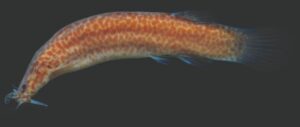
Ituganis crispim. From: Donin, L. M., Pinna, M. C. C. de, Severi, W., & Ramos, T. P. A. 2023. Filling in a biogeographic gap: the first Trichomycteridae from the Parnaíba River basin (Siluriformes: Trichomycteridae). Neotropical Ichthyology v. 21 (no. 2), e230018.
Two catfishes from the rio Parnaíba are named for “Gourd Head”: Parotocinclus cabessadecuia Ramos, Lima & Ramos 2017 (Loricariidae), and Ituglanis crispim Donin, de Pinna, Severi & Ramos 2023 (Trichomycteridae). Neither fish has a gourd-shaped head.
In 2003, Teresina, a city at the confluence of the Parnaíba and Poti Rivers, instituted Cabeça de Cuia Day, celebrated on the last Friday of April. A statue of Cabeça de Cuia (shown above) welcomes visitors to the city. To date, no devoured virgins named Maria have been reported.
17 May
The 500th Name of the Week
When I posted my first “Name of the Week” on 17 October 2013, I never imagined that 499 weeks later — 9-1/2 years! — I’d still be doing the same. I credit the diversity of fishes and fish names to keep feeding me material. And I credit you, for reading and sharing these posts, for your positive comments both public and private, and for gently correcting me when I am wrong.
I would like to use this opportunity to provide an update on The ETYFish Project. I finished my first run-through of all the valid genus- and species-level names in September 2021 — 42,192 entries. Then, in addition to continuing to add new species and stay on top of taxonomic revisions and nomenclatural changes — resulting in a new total of 42,650 entries as of today — I turned my attention to several long-term initiatives to improve the site’s utility and content:
#1) Go back to the beginning (hagfishes) and re-research every name and, when necessary, revise or rewrite every entry. I’ve learned a lot since I began studying fish names in 2009. Plus, with the increasing digitization of scientific journals and other texts, I now have more resources from which to draw. My first run-through was a solid first draft. The second draft allows me to correct errors, strengthen my understanding of Latin and Greek (see #2), and make discoveries that eluded me the first time. (One example is below.)
#2) Add detailed etymologies of Latin and Greek words. My first draft focused on the semantics of fish names, i.e., what they mean and how they apply to the fish in question. With the tireless assistance of Holger Funk, revised entries now include the etymological origins of a name’s Greek or Latin components. One example: For descriptive names that contain the suffix “-oides,” I had simply translated it — “having the form of” — without explaining whether the suffix was Latin or Greek. Now such entries are being expanded to read “-oides, Latinized suffix adopted from eī́dos (Gr. εἶδος), form or shape.” Such additions strengthen the “ETY” of ETYFish. Thank you, Holger!
#3) Build a searchable database. When I started The ETYFish Project, I focused on research, writing and tracking down an estimated 13,600 taxonomic references. I gave little thought as to how the information should be presented. I created simple HTML pages via WordPress with links to PDF versions. But I quickly realized that searching ETYFish was a cumbersome chore that generated poor results. As I began the ETYFish 2.0 (the “second draft”), I began to concurrently add the revised entries to a searchable database. Thanks to the kind people at Caspio, who are providing free access to their platform, you can now search over 8,100 names — Myxinidae through Danionidae — by family, genus, species, author, or any search term you wish. The database is only 19% complete, but I am adding to it every month.
#4) Make the PDFs more appealing. As a bibliophile and a “baby boomer” more comfortable with print than pixels, I enjoy making PDFs in order to give the information a printed, “book-like” quality. Now, in order to make long PDFs of dictionary-style text visually interesting, I am including for each genus an illustration or photograph of a representative species. Unless otherwise indicated in the caption, these images are reproduced from the publications in which the names were proposed. I find it fascinating to see how ichthyological images have evolved over the centuries from lithographs to in situ digital photographs. In addition, I am now integrating many of these “Name of the Week” essays into the PDFs. Families Myxinidae (hagfishes) to Danionidae (danios and rasboras) are in this new format.
As mentioned above, my re-researching of fish names is yielding some new discoveries. Some of them have been featured in recent “Name of the Week” entries. Here’s another:
Enteromius arcislongae (Keilhack 1908) is a minnow endemic to Africa’s Lake Malawi. Here is what I posted about the meaning of “arcislongae” back in 2013:
etymology not explained but here is a guess: arcis, arc or bow, referring to downward arc of lateral line seen in many small Enteromius; long, referring to greater number of lateral line scales compared to E. trispilopleura, which would make downward arc of lateral line longer

Enteromius arcislongae. From: Keilhack, L. 1910. Njassa-Fische gesammelt von Prof. Dr. Fülleborn. Mitteilungen aus dem Zoologischen Museum in Berlin 5 (1): 90–115, Pls. 1–2.
I cringe when I read that today. My attempt at a guess was clunky and amateurish. And yet it remained on the website for 9+ years until I re-researched it a few weeks ago. That’s when I discovered that Keilhack wrote a follow-up description two years later (1910), in which he explained the name. It means “of Langenburg,” a colonial German town (now called Lubila) at Lake Malawi, Tanzania, at or near where the minnow was discovered. The name is a combination of arcis, Latin for castle, and longus, Latin for long. Langenburg, in English, means “long castle.”
As you can see, my original guess wasn’t even close.
I am already thinking about NOTW #501.
10 May
Plain, drab and unassuming
Sometimes the most distinctive thing about a fish is the degree to which it is not distinctive. It’s easy to name a fish that is brightly colored or patterned. But what if the fish being described is, well, nondescript?
The Latin adjective modestus means moderate, modest or unassuming. I count 23 currently valid fish species named either modestus (masculine) or modesta (feminine). In 17 of these descriptions, the author did not explain why he chose this particular adjective. It’s almost as if he was too bored or unimpressed with the fish to justify the name. In these cases, I’ve had to extrapolate a meaning from clues given in the text. A few examples:
Roa modesta (Temminck & Schlegel 1844) “The colors of this fish are not very bright” (translation)
Gonialosa modesta (Day 1870) perhaps referring to its snout “moderately projecting over the lower jaw” and/or its “uniform” coloration
Melanorivulus modestus (Costa 1991) male color pattern described as “discreet” (translation)

One of these Pimelodella catfishes is named “modestus.” Can you tell which one? From: Günther, A. 1860. Third list of cold-blooded vertebrata collected by Mr. Fraser in Ecuador. Proceedings of the Zoological Society of London 1860 (pt. 2) (art. 8): 233-240, Pisces Pl. 10.
Sometimes it’s helpful to compare “modestus” fishes with closely related congeners:
Pimelodella modestus (Günther 1860) perhaps referring to its less elongate shape and/or lack of spots on caudal and dorsal fins compared with Pimelodella elongatus, described and illustrated in the same publication (shown here)
Homalopteroides modestus (Vinciguerra 1890) perhaps referring to its grayish coloration compared with the more-colorful Homaloptera bilineata, its presumed congener at the time
Lepidotrigla modesta Waite 1899 perhaps referring to shorter pectoral fin (reaching first anal-fin ray) compared with the Lepidotrigla mulhalli (reaching sixth ray)
Brown is a common color of “modestus” fishes:
Thamnaconus modestus (Günther 1877) perhaps referring to uniform brownish-gray color in alcohol (a less modest greenish-yellow in life)
Stigmatochromis modestus (Günther 1894) perhaps referring to its uniform brownish-black coloration
Neolamprologus modestus (Boulenger 1898) described as having a uniform brown coloration in alcohol
Platypanchax modestus (Pappenheim 1914) possibly referring to its light yellowish-brown color in alcohol and/or lack of bright colors on sides and fins of males
Cyphocharax modestus (Fernández-Yépez 1948) name dates to a 1906 museum label, possibly referring to its yellowish-brown coloration
Easily the most distinctive use of the “modestus” adjective is for Pungitius modestus Matsumoto, Matsuura & Hanzawa 2021, a stickleback from Yamagata Prefecture, northern Honshu, Japan. The authors selected “modestus” for the fish’s “moderate” behavior. Unlike other Pungitius species, which swim in the water column, this one tends to hide in aquatic grasses, and frequently remains still just above the bottom. What’s more, adults do not fight each other except during breeding season.
With the sole exception of the stickleback, it seems “modestus” is the nomenclatural equivalent of shrugging your shoulders and saying “Meh.”
3 May
Eliminating eponyms? A supremely bad idea
On 13 March, a provocative editorial was published online calling for the elimination of eponyms, i.e., biological epithets named after people. The authors state that “naming species in honour of real people is unnecessary and objectively difficult to justify. The Earth’s biodiversity is part of a global heritage that should not be trivialized by association with any single human individual, whatever their perceived worth.”
The authors bemoan the fact most eponyms, especially those proposed in the 19th and early 20th centuries, honor people “strongly associated with the social ills and negative legacy of imperialism, racism and slavery,” or otherwise were proposed by “white men who, by and large, honoured other men (funders, colleagues, collectors and so on) of their own nationality, ethnicity, race and social status.” The authors isolate Africa as a textbook example of eponymic inequality. Among the non-fish vertebrates described from that continent, anywhere from 9%-23% of the species (depending on the country) are named after people associated with European colonialism and imperialism. (I suspect that the percentages for fishes named after such Europeans is even higher.) In response to these inequalities, the authors suggest two major reforms: to rename all plant and animal taxa named after humans, and to rewrite nomenclatural codes to preclude (or at least “severely limit”) eponyms for newly identified taxa.
While I acknowledge a global imbalance in eponyms, and that some eponyms may be innocuous to some and offensive to others, I cannot support the renaming and outright elimination of eponym for six reasons.
#1. Changing names would disrupt nomenclatural stability. Nomenclature requires stability in order to be effective. A name is a unique identifier. It is attached to a species and fixed in the literature so that biologists and others can track and access what’s been written about that species through time. Changing that name disrupts this stability. Now there are two names to deal with: the name of the species in the past, and its new name going forward. The authors of the editorial downplay the amount of disruption this instability would cause. (As far as I can tell, none of them are working taxonomists.)
#2. Changing names would be a massive and costly task. While the authors acknowledge that changing eponyms “would have technical and administrative costs (especially for low-income and middle-income countries),” they naively suggest that “biodiversity information systems” would keep it all neat and tidy. Sorry, it’s not that easy. Approximately 20% of all animal names are eponyms. There are an estimated 1,594,420 animal species on Earth. That’s an estimated 318,884 animals that would have to be renamed! Who manages this task? Who pays for it? Systematics and taxonomy are poorly funded as it is. There can be no doubt that the herculean task of renaming 318,884 animals for ideological reasons would siphon funds away from the more urgent tasks of describing the unknown large numbers of taxa that remain undescribed and conserving the species that have not yet gone extinct.
The authors go on to suggest that the “task of renaming eponyms could be given to taxonomists from the biogeographical region of the candidate species.” An obvious flaw in this approach is that many marine taxa occur in international ocean waters, and in polar regions with no indigenous human inhabitants. Who renames those?
#3 Replacement names would bury taxonomic history. Here’s an example of how renaming an eponym is fraught with complications and could effectively bury taxonomic history. The coelacanth Latimeria chalumnae was described from off the coast of East London, South Africa, by the famous South African ichthyologist J. L. B. Smith in 1939. Smith, born in South Africa, was a White male of English descent in a country ruled by a minority White population that institutionalized the dominance by White people over people of other races. Smith named the genus Latimeria after Marjorie Courtney-Latimer, a White female (also of English descent) who worked as a museum curator. Courtney-Latimer found the coelacanth in a fisherman’s catch, trawled off the Chalumna River near East London, South Africa, on 23 December 1938. Realizing it was a unique specimen of potentially great scientific importance, she undertook great efforts to preserve the specimen for science. Smith was stunned when he saw Courtney-Latimer’s sketch of the fish, because coelacanths were thought to have been extinct for 65 million years.
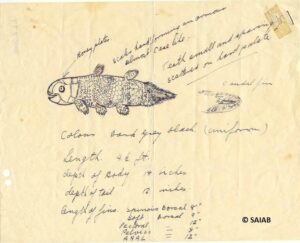
The sketch of an odd fish that Marjorie Courtney-Latimer sent to J. L. B. Smith on Christmas Eve 1938. Smith confirmed this fish to be the first specimen of the “living” coelacanth.
The specific name of the coelacanth, chalumnae, is a toponym, named for the Chalumna River. The generic name Latimeria, though, is an eponym, that would need to be changed per the authors’ proposal, preferably by a South African taxonomist of non-European descent. Let’s say, for hypothetical purposes only, that the coelacanth genus was renamed by the two African authors of the editorial, Bako (Nigerian) and Wabala (Kenyan). And let’s say, for hypothetical purposes only, that they replaced Latimeria with Gombessa, the name by which the South African coelacanth was historically known by fishermen around the Comoro Islands in the western Indian Ocean, where a second coelacanth specimen was found in 1952. Now compare the two names:
Latimeria Smith 1939
Gombessa Bako & Wabala 2023
By replacing Latimeria we are in effect stripping the famous scientific history of the fish from its name. Gone would be the name of the person who made this important scientific discovery possible. Why? Because the authors “believe that naming a biological species after a human was and is never right — regardless of good intentions.” (I assume the authors’ belief extends to biological genera, not just species, as well.) Also gone from the name would be the ichthyologist (Smith) whose obsessive 13-year quest for a second specimen has been documented in numerous popular books, replaced by the names of workers assigned the administrative task of renaming “unjustifiable” eponyms. (I am not singling out Bako & Wabala; I am simply using their names since they are co-authors of the editorial.) Even the date of the hypothetical new name (e.g., 2023) is problematic. This suggests the coelacanth was a recent discovery when in fact it was discovered and described 84 years ago.
The authors claim that “name revisions would not alter scientific history, as the historical name would remain as a synonym and the identity of the individuals who initially described the species would remain unaltered.” True, name revisions would not alter history. But they would bury history and effectively replace it. “Gombessa” would be a superb name for a new coelacanth taxon should another be discovered. But as a replacement name, “Gombessa Bako & Wabala 2023” tells us nothing about the extraordinary events behind what has been called the most valuable zoological find of the 20th century.
#4 Changing names will not benefit conservation. The authors of the editorial state that reforming taxonomy to remove eponyms “could bring multiple benefits for both conservation and society,” leading to a “reinvigoration of local and national interests in biodiversity and its cultural value.” In other words, the authors are suggesting that once a potentially offensive eponym is replaced, then local scientists and the public at large would be more interested in studying and protecting the renamed taxon. There is no evidence that I know of — and the editorial presents none — that biological eponyms have harmed anyone, and that researchers and nature enthusiasts are refusing to study species, or are uninterested in them, because of their scientific names. Herpetologist Luis Miguel Pires Ceríaco addressed this issue on ResearchGate, in his response to the editorial [edited slightly for clarity]:
My fellow African colleagues and students face several difficulties — lack of infrastructure, lack of funds, lack of recognition by their own governments and society, lack of opportunities, lack of jobs, etc. These issues are indeed affecting their capacity to keep doing science. Poverty also leaves many bright young students outside the universities. Eponyms? I don’t know a single case of an African researcher who decided to leave science due to eponyms. … I had the opportunity to discuss this topic with many of them. The most common response? A loud laugh. In fact, renaming names simply based on ethical grounds would make life worse for these researchers. If you already have a considerable lack of tools and access to bibliography [e.g., scientific literature], then the constant renaming of these names would simply make it even more difficult, if not impossible, to follow. If this is true to researchers with access to good libraries (both physical and virtual), then imagine for those whose libraries are barely existent.
#5. Biological eponyms are a Linnaean innovation that humanize science. The authors’ belief that naming a species after a person is “never right” is their personal opinion and should not be forced upon other taxonomists. My opinion is that eponymy should not be eliminated because it’s been a part of binominal nomenclature since its very inception. When Linnaeus introduced the nomenclatural system that all biologists use today, he introduced another innovation: the eponym.
Before Linnaeus, naming a plant or animal was simply an exercise in description. But Linnaeus separated naming from description. A name may be descriptive: parvus for small, maculatus for spotted, and so forth. But Linnaeus opened the door for “non-descriptive” names, allowing biologists to be creative, to express themselves, and, in the form of eponyms, to honor fellow humans. Describing a species is objective, based on measurement, observation, data and analysis. Naming a species is not. It’s a human construct, created by humans for use by other humans. Eponyms (and other creative names) humanize science and mirror humanity — its virtues, weaknesses and foibles — and its history. You can trawl through almost anyone’s history and find something unsavory about them. But that doesn’t mean they should be “canceled.” Linnaeus himself benefited from specimens transported via slave ships. Should we cancel Linnaean taxonomy also?
#6. “Old” names can coexist with new ones. There is no denying that Western Europeans — White, privileged men — dominate biological eponyms. There is a simple reason for this. Western Europeans created taxonomy and binominal nomenclature and, for many years, were the only people describing new species. Yes, many of these new species were collected during voyages that almost always had objectives far less noble than the pursuit of knowledge — establishing trade routes, building empires and exploiting resources (including, tragically, humans). But the naturalists aboard these voyages were serious about their science. Their contributions should be remembered, not erased. Instead of changing the names of the species they described, let’s instead concentrate our energies and resources into naming the untold millions of species they didn’t describe.
Today, there is a new generation of biologists who hail from every continent, reinvigorating systematics and taxonomy with new techniques, while relying on the collections of Western Europeans (and others) for baseline data on historical patterns of distribution and abundance. If the work of contemporary South American ichthyologists is any indication, then these taxonomists are also reinvigorating nomenclature by coining new-taxa epithets derived from indigenous languages and inspired by indigenous peoples, history and culture.
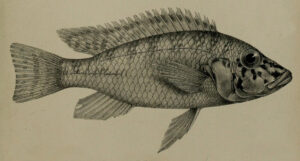
Shuja horei. From the original description: Günther, A. 1894. Descriptions of the reptiles and fishes collected by Mr. E. Coode-Hore on Lake Tanganyika. Proceedings of the Zoological Society of London 1893 (pt 4) (art. 2) (for 7 Nov. 1893): 628-632, Pl. 58.
There is plenty of room and opportunity in biological nomenclature for past and present sensibilities to coexist. Take, for example, the name of the African cichlid Shuja horei. The species was described as Chromis horei by Albert Günther, a White male of German descent, in 1894. He named the species in honor of Capt. Edward Coode Hore (1848-1912), a British missionary, explorer, navigator and cartographer who collected the holotype from Lake Tanganyika when Zanzibar (now part of Tanzania) was a British protectorate. In 2022, three ichthyologists, including a native Tanzanian, proposed a new genus for the species, which they named Shuja, from the Swahili noun shujaa, a brave person or warrior, referring to the “notable” territorial behavior of males. (Swahili is the national language of Tanzania.) The new binominal Shuja horei, combining an African noun with a colonial eponym, preserves the nomenclatural history of the fish while reflecting an indigenous influence. Of course, not every binominal can be structured this way. My point is to demonstrate that we need not erase the past in order to reflect the present.
For these reasons, I cannot support the authors’ desire to rewrite 270 years of nomenclatural history. The value of maintaining nomenclatural stability far outweighs any social or conservation benefits the authors (vaguely) claim that removing eponyms would bring. Their proposals are impractical, fraught with complications, and seem to lack an appreciation for taxonomy and nomenclature.
A final comment about the editorial: The authors cite but gloss over an official statement issued on 11 December 2022 by the International Commission of Zoological Nomenclature: “Replacing accepted scientific names because of perceived offensiveness is not, and should not be, regulated by the Code. Although the Commission recognizes that some scientific names might cause discomfort or offence to parts of the community (such as eponyms of dictators or historical figures considered by some as racists, or because a word currently has negative connotations), the commitment to a stable and universal nomenclature remains the priority. It is well outside the scope of the Commission to assess the morality of persons honoured in eponyms or the potential offensiveness or inappropriateness of certain names.”
26 April
An aviary of fishes (part 2)
Here is the second of two parts showcasing fishes scientifically named after birds.
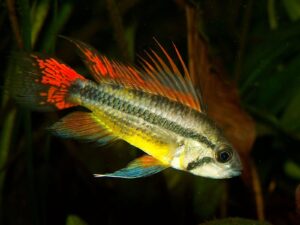
Apistogramma cacatuoides, male. Photo by William Kreijkes. Source: Wikipedia.
Cockatoo
The Cockatoo Dwarf Cichlid Apistogramma cacatuoides Hoedeman 1951, from the Amazon River basin of Peru and Columbia, is an aquarium favorite. Its name has the Latin suffix –oides, meaning “having the form of,” in this case having the form of the cockatoo bird genus Cacatua. Hoedeman did not explain the allusion but he almost certainly was comparing the male’s produced dorsal-fin lappets with the produced head feathers of the cockatoo.
Magpie
The Painted Sweetlips Plectorhinchus pica (Cuvier 1828) is a member of the grunt family Haemulidae. It occurs in lagoons and seaward reefs throughout much of the Indo-West Pacific. Its specific epithet refers to the black-and-white color of juveniles, similar to the color of the European Magpie Pica pica. For decades, ichthyologists treated the name as an adjective, spelling it picus to agree with the masculine gender of the genus. I alerted Eschmeyer’s Catalog of Fishes about the error in 2020 and the correct spelling is slowly being adopted by online references.

“Guacamaya,” later named Scarus guacamaia. From: Parra, A. 1787. Descripción de diferentes piezas de Historia Natural, las más del ramo maritimo, representadas en setenta y cinco láminas. Havana: Imprenta de la Capitanía General. 1-195 + i-v, Pls. 1-73.
Macaw
At least four parrotfishes (Labridae, but often placed in their own family, Scaridae) are named for their parrot-like beak (which they use to rasp algae from coral and other rocky substrates) and/or their bright coloration. I like the name of this one: the Rainbow Parrotfish Scarus guacamaia Cuvier 1829, which occurs in the western Atlantic from Bermuda to Venezuela. Although Cuvier is credited with “naming” the species, he merely borrowed (and Latinized) the Cuban name for the fish, guacamaya, as reported by Portuguese naturalist Antonio Parra y Callado (1739-?) in his book Descripción de diferentes piezas de Historia Natural. This book, published in 1787, is believed to be both the first scientific treatise and first illustrated book published in Cuba. Guacamaya is the Spanish word for macaw and, according to Parra, also the local Cuban name for this fish. Parra ascribed the name to both the fish’s macaw-like beak and coloration. The illustration accompanying Parra’s account — drawn by his son Manuel Antonio Parra y Muñoz — is shown here.
Birds-of-paradise
According to Venetian scholar and explorer Antonio Pigafetta (ca. 1491-ca. 1531), native New Guineans called the long-plumaged birds of their forests “birds of god,” believing they came from a terrestrial paradise. The connotation stuck. Linnaeus, in his 1758 Systema naturae, the starting point of zoological nomenclature, officially called the birds-of-paradise genus Paradisaea, a Neo-Latin adjective derived from the Greek parádeisos, meaning paradise. In that same publication Linnaeus included Polynemus paradiseus, from the threadfin family Polynemidae. Linnaeus did not explain the meaning of the name but my guess is that he was comparing the fish’s extremely long pectoral filaments to the elongate feathers of Paradisaea.
Cuckoo
The Red Gurnard Chelidonichthys cuculus (Linnaeus 1758) of the of the eastern Atlantic, Mediterranean and Black Sea doesn’t look like a cuckoo bird, but apparently it sounds like one. The specific name cuculus is Latin for cuckoo, a name that traces back to Aristotle, who claimed that this gurnard, or gurnards in general, make cuckoo-like noises when pulled from the water.
19 April
An aviary of fishes (part 1)
Many fishes are named for their resemblance to terrestrial animals. Especially birds. Here’s a sampling of five fish species, from among dozens, that connect feather with fin. (Next week, another five.)
Eagle
Three fish species are named aquila, the Latin word for eagle. One of these is the Common Eagle Ray Myliobatis aquila (Linnaeus 1758) of the eastern Atlantic, Mediterranean and southwestern North Sea. Its name refers to the broad eagle-like wingspan formed by its fused pectoral fins.

Guineafowl Puffer, photo by Bryan Harry, National Park Service.
Guineafowl
If a fish has innumerable small white or silvery spots all over its body, there’s a good chance it will be named meleagris, Greek for guineafowl, referring to the distinctive color pattern of the Helmeted Guineafowl Numida meleagris. I count eight fishes with the name, the earliest being the Guineafowl Puffer (Anonymous 1798), from the Indo-Pacific and Eastern Pacific. This puffer occurs in three color patterns: a dark form with many white spots (for which it is named, shown here), a yellow form, and a combination of the two. Its “Anyonymous” authorship warrants explanation. French naturalist Philibert Commerçon (also spelled Commerson, 1727–1773) gave it the meleagris monicker in an unpublished manuscript. Lacepède called it only by its vernacular name “Le tétrodon méléagris” in the first volume of his Histoire naturelle des poisons (1798). Its first appearance as a proper binomial, Tetrodon meleagris, appeared in an anonymous review of Lacepède’s book later in 1798.
Chaffinch
The Staghorn Thicketgoby (cool name!) Pleurosicya fringilla Larson 1990 is a small (2.2 cm TL) semi-transparent goby that inhabits branches of Acropora corals in the tropical Indo-west Pacific. Goby expert Helen Larson named it after Fringilla Leach 1820, a genus of Old World finches called chaffinches, referring to the goby’s “tiny bird-like appearance.”

Pelican Eel, probably the first-published image of the species. From: Filhol, H. 1884. La vie au fond des mers, les explorations sous-marines et les voyages du Travailleur et du Talisman. Paris: G. Masson. viii + 301 pp.
Pelican
The deep-sea Pelican Eel Eurypharynx pelecanoides Vaillant 1882 is the only member of its family (Eurypharyngidae). Its name means “pelican-like,” referring to its large mouth and throat, similar to that of the bird.
Woodcock
Linnaeus named the woodcock genus Scolopax in Systema naturae, the first official work of zoological nomenclature, in 1758. Scolopax is Latin for snipe of woodcock. In the same publication Linnaeus also named the Longspine Snipefish Balistes (now Macroramphosus) scolopax, found worldwide in tropical to subtropical ocean waters. Both fish and bird have extremely long bills or snouts.
12 April
One letter makes a difference
Last week we showed how two specific names, derived from the same source and meaning the same thing but differing in their spelling, are not considered homonyms per the rules of zoological nomenclature. This week we look at two generic names that would be homonyms were it not for the addition or replacement of a single letter.
Labiobarbus and Labeobarbus
In 1823, Dutch physician and biologist Johan Coenraad van Hasselt (1797–1823) proposed Labiobarbus, a genus of cyprinid fishes (Family Cyprinidae, Subfamily Labeoninae), now comprising eight species from Southeast Asia. Van Hasselt said that his new genus possessed four small barbels just like members of the genus Labeo Cuvier 1816, and a single dorsal fin with an unserrated second ray, just like members of the genus Barbus Daudin 1805. (At the time, Labeo and Barbus were among the first cyprinid genera described and known by naturalists.) Based on this comparison, van Hasselt coined a new name that combined Labeo + Barbus. But for some reason, van Hasselt consistently spelled the “Labeo” portion of the name as “Labio” in his text (three times, to be exact). This was not a printing error since van Hasselt’s handwritten manuscript survives and clearly shows an “i” instead of an “e.” Since there is no internal evidence of a typographical error, the “Labiobarbus” spelling must be retained.

Labeobarbus nedgia. Note its “unusually thick fleshly lips.” From: Rüppell, W. P. E. S. 1835. Neuer Nachtrag von Beschreibungen und Abbildungen neuer Fische, im Nil entdeckt. Museum Senckenbergianum: Abhandlungen aus dem Gebiete der beschreibenden Naturgeschichte, von Mitgliedern der Senckenbergischen Naturforschenden Gesellschaft in Frankfurt am Main 2 (1): 1-28, Pls. 1-3.
Perhaps unaware of Labiobarbus — the name remained in obscurity until American ichthyologist Hugh M. Smith dusted it off in his 1945 monograph on the freshwater fishes of Thailand — German explorer-naturalist Eduard Rüppell (1794–1884) had the same idea for a name in 1835. He combined Labeo + Barbus for a new genus and species of cyprinid (Subfamily Torinae) from Africa, Labeobarbus nedgia. Labeo is Latin for “one with large lips,” referring to the fish’s “unusually thick fleshly lips” (translation). Barbus was at the time a catch-all genus for many African, Asian and European cyprinids. By coining this name, Rüppell was calling his new genus “the Barbus with large lips.” (The specific name nedgia was, according to Rüppell, what the locals called it at Lake Tana, Ethiopia.)
Many morphological differences separate Labeobarbus from Labiobarbus. But their names are just a single letter apart.
Barbodes and Barboides
The catch-all genus Barbus inspired another pair of near homonyms. In 1859, Dutch army surgeon and ichthyologist Pieter Bleeker (1819–1878) proposed a new genus of Southeast Asian cyprinids, Barbodes. The –odes suffix is an alternative spelling of –oides, derived from the Greek eī́dos (εἶδος), meaning form or shape. In other words, the name means Barbus-like, referring to its similarity to and/or affinity with Barbus.
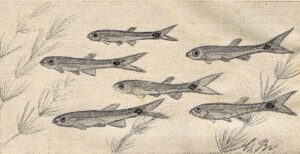
Shoal of Barboides gracilis in the aquarium. Illustration by Christian Brüning. From: From: Brüning, C. 1929. Panchax nigeriensis und Barboides gracilis, die westafrikanische Schlankbarbe. Wochenschrift für Aquarien- und Terrarienkunde 26 (27): 419‒420.
Seventy years later, a German aquarist named Christian Brüning reported on a shipment of live fishes from West Africa. Among them was a group of “very pretty, magnificently shiny, red-gold little fish,” Brüning wrote in a German aquarium journal, with a “large black diamond spot at the root of the caudal fin” (translation). Enchanted with the fish and convinced it was a new species, he decided it needed a name. He called it Barboides gracilis: gracilis, Latin for thin or slender, referring to its “delicate shape” (translation), and Barboides, i.e., Barbus-like. Unlike Bleeker, Brüning spelled the –oides suffix the way it’s usually spelled, with an “i.”
It’s unclear whether Brüning was formally naming the fish or just giving it a name for convenience. It’s also unclear whether he realized he was proposing both a new genus and species and that Bleeker had proposed a nearly identical name in 1859. In fact, Brüning wasn’t sure whether the fish was a minnow or a tetra. He said he would “leave it to the scholars, if the gentlemen are interested, to place it with the Cyprinids or among the Characinids, wherever they think it belongs” (translation). Despite its shortcomings, Brüning’s description fulfilled the requirements of zoological nomenclature at the time. (They have since been tightened to discourage and disqualify such casual and amateur descriptions.) What’s more, his instincts were correct. Barboides remains a valid genus of miniature cyprinids (maximum size 22.5 mm SL), now with a second species, B. britzi, described in 2006.
No two animal taxa can have the same name. With the addition of a single letter, Barbodes and Barboides are not the same.
5 April
Symphurus plagiusa or Symphurus plagusia? How about both?
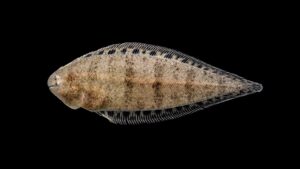
Symphurus plagiusa. Photograph by Jesse Bissette. Courtesy: NCFishes.com
Immediately after I gave my presentation “Adventures in Etymology” at the 2023 NANFA Convention in Columbia, South Carolina, I was asked an intriguing question. Scott Smith, a biologist with the North Carolina Division of Marine Fisheries — and a superb fish photographer who the day before demonstrated his innovative techniques in the field — wanted to know why two species of tonguefishes (Cynoglossidae) from the western Atlantic had nearly identical names:
Symphurus plagiusa (Linnaeus 1766) — Blackcheek Tonguefish, found in estuaries from New York to the Gulf of Mexico
Symphurus plagusia (Bloch & Schneider 1801) — Duskycheek Tonguefish, found in estuaries from Cuba to Brazil
As you can see, the specific epithets are the same except for the order of the fifth, sixth and seventh letters: –ius in the northern species, –usi in the southern. The fact that the two species are in the same genus in the same ocean compounds the confusion and the potential for nomenclatural and taxonomic mix-ups. How can this be? Is this even allowed?
I pulled out my phone and called up the Symphurus entries at etyfish.org. As it turns out, the two names are derived from the same source. Indeed, one of the names is likely a misspelling. Here’s what happened:
In 1756, Patrick Browne (1720–1790), an Irish physician and botanist who settled in Jamaica, published a book about his adopted homeland, The Civil and Natural History of Jamaica. In the book he wrote about a fish he called Plagusia, “The little brown Sole with a pointed tail.” Browne did not explain the meaning of the name, but we can guess that it derives from the Greek plágios, meaning oblique, slanting or sideways, perhaps referring to how the fish’s body tapers towards the tail. Whatever its etymology, Browne’s name has no taxonomic standing since it is non-binominal (proposed without a species) and predates the official start of zoological nomenclature by two years. (Note: the name Plagusia would surface again in 1804, proposed for a genus of crabs —referring to their sideways gait? — that is still in use today.)
From 1760 to 1771, physician-naturalist Alexander Garden (1730-1791), of Charleston, South Carolina (USA), sent fish skins mounted on paper to Carl Linnaeus, the father of taxonomy. One of these, sent in 1761, was a fish labeled with the names “Plagiusa” and “Taper Flounder.” My guess is that Garden identified his fish as the same as Browne’s Plagusia but misspelled the name on the label. Linnaeus, apparently unaware of Browne’s publication, repeated the misspelling when he officially named the species — Pleuronectes plagiusa, now known as Symphurus plagiusa Blackcheek Tonguefish — in 1766.
In 1801, Bloch & Schneider, in their Systema Ichthyologiae, treated Browne’s Plagusia as a distinct species, which they called Pleuronectes plagusia — now known as Symphurus plagusia Duskycheek Tonguefish — following Browne’s original spelling and crediting him with the name. It is not clear whether Bloch & Schneider were aware of Linnaeus’ plagiusa. If they were, it appears they disregarded it since Browne’s account appears to have priority. (Browne’s book, published again in 1789, was later deemed unavailable for nomenclatural purposes.)
Unbeknownst to everyone at the time is that the two spellings actually — and accidentally — refer to two different species. Among other differences, the Garden/Linnaeus tonguefish from South Carolina has a rounded snout and 81-91 dorsal-fin rays, whereas the Browne/Bloch & Schneider tonguefish has a long, squarish snout and 89-97 dorsal-fin rays.
The International Code of Zoological Nomenclature forbids homonymy. Two or more taxa simply cannot have the same name binominal. But Symphurus plagiusa and Symphurus plagusia are not the same. The names are close to being homonyms. But, as the saying goes, close only counts in horseshoes (and hand grenades).

Caroline Henry, circa 1855.
29 March
Cottus carolinae Gill 1861
In 1861, American zoologist Theodore Gill (1837-1914) named the Banded Sculpin Cottus carolinae, a wide-ranging freshwater denizen east of the Mississippi River in the USA, after Caroline Henry (1839-1920). Caroline was the 21-year-old daughter of Joseph Henry (1797-1878), the first Secretary of the Smithsonian Institution.
Gill’s etymology says: “I have given myself the pleasure of dedicating this fine species to my estimable young friend, Miss Caroline Henry.”
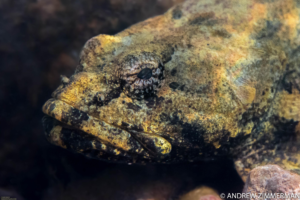
Cottus carolinae. © Andrew Zimmerman. andrewzimmermanphotography.shootproof.com
We do not know anything about Gill’s relationship with Miss Caroline, but one can guess Gill honored her in order to curry favor with her dad. It must have worked. Henry hired Gill in 1861 to be in charge of the Smithsonian’s scientific library. In 1866, the library moved to the Library of Congress and Gill moved with them, but he retained his quarters at the Smithsonian for his ichthyological work.
I do not know what became of Miss Caroline, but I do know this: If I were her, I would have preferred a less unattractive fish to bear my name.
22 March
American firsts (part 3)
The first Mexican freshwater fish described by a Mexican:
Girardinichthys viviparus (Bustamante 1837)
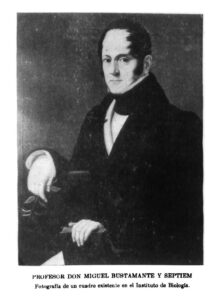 Miguel Francisco Nepomuceno María José Ignacio Bustamante Praxedis Septién (1790-1844) was Professor of Botany at the Royal School of Mines and in charge of the Royal Botanical Gardens in Mexico City (1826-1844). In 1837, he published a brief, one-page description of a small fish that was abundant in Mexico City, where it was sold for food, mainly for the poor. Bustamante named it Cyprinus viviparus, believing it was a type of carp or minnow that gave birth to live young, hence the name viviparus (=livebearer). The species is now known as the Chapultepec Splitfin Girardinichthys viviparus. It’s not a minnow but a goodeid (Goodeidae, subfamily Goodeinae), a group of livebearing fishes endemic to Mexico.
Miguel Francisco Nepomuceno María José Ignacio Bustamante Praxedis Septién (1790-1844) was Professor of Botany at the Royal School of Mines and in charge of the Royal Botanical Gardens in Mexico City (1826-1844). In 1837, he published a brief, one-page description of a small fish that was abundant in Mexico City, where it was sold for food, mainly for the poor. Bustamante named it Cyprinus viviparus, believing it was a type of carp or minnow that gave birth to live young, hence the name viviparus (=livebearer). The species is now known as the Chapultepec Splitfin Girardinichthys viviparus. It’s not a minnow but a goodeid (Goodeidae, subfamily Goodeinae), a group of livebearing fishes endemic to Mexico.
Unfortunately, the fish is not so abundant today. It is an endangered species in Mexico, with much of its range impacted by pollution and non-native fishes. The largest remaining population is believed to be in an artificial lake in Chapultepec Park in downtown Mexico City.
Over a century later, Bustamante was honored in the name of a different Mexican fish, the (now extinct) minnow Evarra bustamantei, in 1955. The author, Leopoldo Navarro G., honored Bustamante precisely for being the first Mexican to scientifically describe a Mexican fish.
The first Canadian freshwater fish described by a Canadian:
Moxostoma hubbsi Legendre 1952
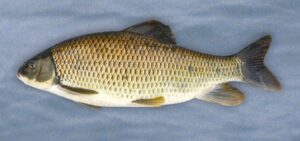
Copper Redhorse, Moxostoma hubbsi. Courtesy: www.canada.ca
The Copper Redhorse Moxostoma hubbsi is an endangered species of sucker (Catostomidae) that currently occurs in only two places: a very small section of the St. Lawrence River and the Richelieu River, both in southern Quebec. (Fossil evidence indicates that it existed as far south as Indiana during the Pleistocene, between 11,000 and 1.8 million years ago.) In 1942, a sharp-eyed Montreal-area commercial fisherman brought the sucker to the attention of government biologists. It was scientifically described a decade later by Vianney Legendre.
Born in Montreal in 1917, Vianney Legendre, devoted his career to studying the fishes of Quebec and Canada. He also taught at the University of Montreal, giving courses in zoology, physiology, ichthyology, comparative vertebrate anatomy, and pharmacodynamics. He remained active in academia until his death in 1990.

Vianney Legendre. Document Management and Archives Division, University of Montreal. Vianney Legendre collection (P271). 1FP, 06380. Vianney Legendre, 194?
Legendre named the Copper Redhorse in honor of legendary American ichthyologist Carl L. Hubbs (1894–1979), the author of a 1930 monograph on sucker classification. Hubbs also advised Legendre on sucker taxonomy.
Legendre was apparently unaware that the Copper Redhorse had already been described (but not named) 76 years earlier. In 1866, Pierre-Étienne Fortin (1823-1888), a Canadian physician, political figure and amateur naturalist, published a detailed description of a redhorse in a list of fishes from the St. Lawrence Gulf and River. But Fortin had confused this species with the Shorthead Redhorse Moxostoma macrolepidotum (Lesueur 1817), so he did not name it. Had Legendre known of this description, would he have named the Copper Redhorse in honor of Fortin instead?
The only two known spawning sites of the Copper Redhorse are in the Richelieu River, downstream from the Saint-Ours Dam. In 2001, the Canadian government built a fishway to help Copper Redhorse reach their spawning site. The fishway is named after the man who named the fish: The Vianney-Legendre Fishway.
15 March
American firsts (part 2)
In two days, I deliver my presentation, “Adventures in Etymology,” at the 2023 Annual Convention of the North American Native Fishes Association (NANFA) in Columbia, South Carolina. My talk will focus on the names of North American freshwater fishes. In recognition of NANFA and its convention, last, this and next week’s NOTW celebrates a total of six “firsts” in the names of North American freshwater fishes.
The first North American freshwater fish described by a natural-born citizen:
Salvelinus fontinalis (Mitchill 1814), Brook Trout
Scottish immigrant Alexander Wilson was the first American to describe a freshwater fish from North America. But who was the first American born in America to do so? That distinction belongs to Samuel Mitchill (1764-1831), who described the Brook Trout, Salvelinus fontinalis, three years after Wilson’s Alosa sapidissima American Shad, in 1814.

Samuel Mitchill, from New York Academy of Sciences (www.nyas.org).
Born in New York in 1764, Mitchill studied medicine at the University of Edinburgh in Scotland. Upon returning to the United States, he studied law and became a lawyer. From 1792 to 1801, Mitchill taught chemistry, botany, and natural history at New York City’s Columbia College. Mitchill was also a politician, serving in the U.S. House of Representatives from 1801-1804 and the U.S. Senate from 1804-1809. In his spare time, Mitchill collected and identified plants and animals from New York State. His primary interest appeared to be fishes. In 1814, he published a 28-page pamphlet, “Report, in part, of Samuel L. Mitchill, M. D., Professor of Natural History, &c, on the fishes of New-York.”
Mitchill’s pamphlet is an amateurish work, demonstrating a poor understanding of fish anatomy and misidentifying several taxa already named by Linnaeus. In fact, Mitchill ignored its existence in future (and significantly better) publications. But the pamphlet, despite its flaws, is historically important, as it represents the first work by an American, native-born or not, to provide a multi-species review of the fishes of a particular region. Many consider Mitchill’s pamphlet to be the starting point of American ichthyology.
Among the 68 nominal fish pecies Mitchill wrote about (including many from marine and brackish waters) is one he called Salmo fontinalis, the “New-York Trout.” Mitchill did not explain the specific epithet but its meaning is clear: “fontinalis” is Latin for “of a spring,” almost certainly referring to the Brook Trout’s fondness for cold, spring-fed water.
The first North American freshwater fish described from west of the Continental Divide:
Richardsonius balteatus (Richardson 1836), Redside Shiner
The three “American first” fishes mentioned so far — Redbreast Sunfish, American Shad and Brook Trout — were described from population centers in eastern North America, specifically from two states (Pennsylvania, New York) that were part of the original 13 British colonies. But North America is a large continent, with vastly different flora and fauna between the Atlantic and Pacific Oceans and a massive swath of then-unexplored wilderness in between. The continent is divided, both geographically and hydrologically, by the Rocky Mountains, which separates the Pacific and Atlantic (including Gulf of Mexico) and Pacific watersheds from Arctic Alaska south through Mexico. What was the first fish to be scientifically described from west of the Continental Divide?
While researching the answer, I established a few conditions. First, I exempted any of the fishes (mostly salmons) encountered during the Lewis and Clark Expedition (1804-1806). While Lewis and Clark were certainly the first American naturalists to encounter and illustrate freshwater fishes from western North America, they did not name them, nor did the editors of their journals. Second, I exempted salmons (Oncorhynchus) of the Pacific Northwest, which were described from the Kamchatka Peninsula of the Russian Far East in 1792. And third, I exempted any freshwater fishes that also occur in, and were possibly described from, brackish or marine waters. These include White Sturgeon, Acipenser transmontanus Richardson 1836, Eulachon Thaleichthys pacificus, (Richardson 1836), and Prickly Sculpin, Cottus asper Richardson 1836. I wanted an inland, obligatory freshwater fish.

Redside Shiner, Richardsonius balteatus, from roughfish.com
You’ll notice that the three above-mentioned fishes all date from “Richardson 1836.” That would be Scottish sur-geon-naturalist John Richardson (1787‒1865), who, in 1836, published a 322-page volume on fishes as part of the four-volume “Fauna Boreali-Americana; or the zoology of the northern parts of British America: containing descriptions of the objects of natural history collected on the late northern land expeditions, under the command of Sir John Franklin, R.N. J. Bentley, London.” Richardson described three freshwater minnows (or leuciscids) in the work, all endemic to western North America: Cyprinus (now Mylocheilus) caurinus, Peamouth (page 304), Cyprinus (now Ptychocheilus) oregonensis, Northern Pikeminnow (page 304), and Cyprinus (now Richardsonius) balteatus, Redside Shiner (page 301).
Because it has page priority in Richardson’s work, I regard Richardsonius balteatus as the first North American freshwater fish described from west of the Continental Divide. The specific epithet “balteatus” is Latin for belted, girdled or banded, referring to the “bright gold-yellow band behind the eye on the margin of the preoperculum” and/or the “broad scarlet-red stripe” beneath the lateral line. Richardson gave the type locality as the Columbia River, probably meaning a smaller stream in the Columbia River drainage, most likely in present-day Washington.
In 1856, French-American ichthyologist Charles Girard created a new genus for Cyprinus balteatus, which he named in John Richardson’s honor: Richardsonius.
Next week: The first Mexican freshwater fish described by a Mexican, and the first Canadian freshwater fish described by a Canadian.
8 March
American firsts (part 1)
Next week, I deliver my presentation, “Adventures in Etymology,” at the 2023 Annual Convention of the North American Native Fishes Association (NANFA) in Columbia, South Carolina. My talk will focus on the names of North American freshwater fishes. In recognition of NANFA and its convention, this and the next two “Name of the Weeks” will commemorate a total of six “firsts” in American ichthyology.
The first freshwater fish described from North America:
Lepomis auritus (Linnaeus 1758), Redbreast Sunfish
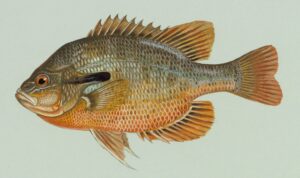
Lepomis auritus. Illustration by Duane Raver, U.S. Fish and Wildlife Service.
The tenth edition of Linnaeus’ Systema Naturae (1758) is the starting point of zoological nomenclature. There is not a single animal in the world whose official scientific name dates to an earlier publication. Linnaeus never visited America, but he knew of several New World fishes that other European naturalists had either collected, illustrated or reported on. He included four North American freshwater fishes in his book: Lepomis gibbosus Pumpkinseed (page 292), Ameiurus catus, White Catfish (page 305), Lepisosteus osseus, Longnose Gar (page 313), and — the first of the four mentioned — Lepomis auritus Redbreast Sunfish (page 283).
Linnaeus called the sunfish Labrus auritus, placing it, along with a number of snappers, sea basses, groupers, and other perch-like fishes, in the genus Labrus (now confined to wrasses, Labridae). The holotype (now lost) was in the private collection of Linnaeus’ fellow Swede, industrialist and entomologist Charles De Geer (1720-1778). It was said to have been acquired in Philadelphia, Pennsylvania. One of the distinguishing characteristics of Linnaeus’ Labrus is a scaled operculum. Indeed, it’s this feature for which the sunfish is named. The Latin adjective “auritus,” meaning “eared,” refers to the sunfish’s long opercular flap (especially in adults).
Because it’s the first of the four New World fishes mentioned in the first official work of zoological nomenclature, I regard Lepomis auritus as the first freshwater fish scientifically described from North America.
The first North American freshwater fish described by an American:
Alosa sapidissima (Wilson 1811), American Shad
The Indigenous peoples of North America had names for many of the continent’s fishes. Most of these names are lost to history and, with rare exceptions — e.g., Esox masquinongy Mitchill 1824, Muskellunge — are not reflected in formal scientific epithets. Since zoological nomenclature was a European invention, it’s no surprise that Europeans dominated the early days of naming North America’s fishes. What’s more, colonists and settlers were too busy taming nature to study it. There were no museums in America, no scientific journals, and no universities to support such work. Benjamin Franklin founded the American Philosophical Society in 1743, to promote the advancement of knowledge in the sciences and humanities, but it was more of an intellectual gentlemen’s club than the scholarly organization it is today.

Portrait of Alexander Wilson, attributed to Thomas Sully.
In the early 1800s, European naturalists began emigrating to America to study the unknown flora and fauna of the fledgling United States. Notable among them was Constantine Samuel Rafinesque (1783-1840), from France and Italy, who settled in America in 1815 and stayed there until his death in 1840. While Rafinesque described 39 freshwater fishes from North America whose names are still in use today, he was not the first European immigrant to do so. That distinction belongs to ornithologist Alexander Wilson (1766-1813).
Born in Scotland, Alexander Wilson emigrated to America in 1794, where he settled in Pennsylvania. He worked as a teacher before turning his attention to ornithology and painting, publishing his nine-volume American Ornithology between 1808 and 1814. Dubbed the “Father of American Ornithology,” his bird paintings inspired James Audubon to do the same.
Wilson also served as an associate editor of Rees’ Cyclopaedia or, Universal Dictionary of Arts, Sciences, and Literature, published in Philadelphia. In 1811, Wilson wrote the entry for Clupea, then a catch-all genus for herrings and shads, for the encyclopedia’s ninth volume. In this entry he names and briefly describes the American Shad, Clupea (now Alosa) sapidissima.
American Shad is an anadromous fish, living in the Atlantic Ocean and migrating to fresh water to spawn. Wilson clearly encountered this shad during its spring spawning run, when pristine, pre-impounded inland waters must have roiled with the fish. “They are for six months about the capes or mouths of large rivers,” he wrote, “that run into the sea. During March, April, and May, they ascend these rivers to the freshes, and thence towards their sources, in order to deposit their eggs in shallow water, where hatching, the young fry descends in the latter part of the summer and autumn to the tide waters, and thence down to the salts: and the adults return likewise to the sea, thin, emaciated, and weak.”
Shad fishing was a large and integral part of the growing economies along the mid-Atlantic Coast, with thousands of fishermen each trapping thousands of migrating shad daily. Colonists loved the tasty roe of female American Shad, and salted shad provided an inexpensive staple during the winter when other sources of protein were scarce.
Historical footnote: Many history books tell the story of how George Washington’s starving troops — and perhaps the fledgling American nation — were saved by an early spawning run of American Shad in the Schuykill River at Valley Forge in March 1778. But as John McPhee explained it in his 2002 natural and cultural history of American Shad, The Founding Fish, the story of the “savior shad” is pure legend.
Pickled, smoked, salted, canned, or planked (broiled over a charcoal fire), the American Shad lives up to its scientific name: sapidissima is Latin for “most delicious,” the very two words Wilson used in his description of the fish.
Next week: The first North American freshwater fish described by a natural-born citizen of America, and the first freshwater fish described from west of the Continental Divide.
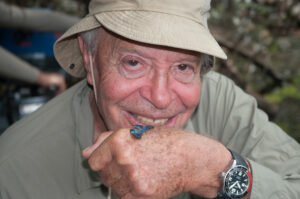
1 March
Patrick de Rham (1936-2022)
Last week I learned that Patrick de Rham, an influential aquarist and amateur ichthyologist passed away in December 2022 at the age of 86.
Born in Lausanne, Switzerland, in 1936, Patrick spent his early boyhood years in the countryside outside of London during World War II. There he collected his first fish, a beautiful male stickleback in breeding colors. This led to a lifetime of collecting fishes anywhere his job (as a freelance ecological consultant) or his passion for fishes took him. He discovered several new species and introduced many others to the aquarium hobby.
Seven species have been named in his honor:
- Bryconalestes derhami (Géry & Mahnert 1977), an African tetra (Alestidae) from Ivory Coast and Liberia. Patrick collected the holotype.
- Rhadinoloricaria rhami (Isbrücker & Nijssen 1983), a suckermouth catfish (Loricariidae) from the upper Amazon River basin of Colombia, Bolivia, Ecuador and Peru. Patrick led the authors’ expedition to Peru and helped collect the type series.
- Aequidens patricki Kullander 1984, a cichlid from the Aguytía and Pachitea rivers (Amazon River basin) of Peru. Patrick helped collect the holotype.
- Anablepsoides derhami (Fels & Huber 1985), a killifish (Rivulidae), from the Amazon River basin of Peru. In addition to collecting the holotype, Patrick was honored for his contributions to the study of Peruvian killifishes.
- Rheocles derhami Stiassny & Rodriguez 2001, a Malagasy rainbowfish (Bedotiidae) from the Amboaboa River of Madagascar. Patrick was honored for his “tireless efforts” to discover and conserve the freshwater fishes of Madagascar.
- Cyphocharax derhami Vari & Chang 2006, a toothless characin (Curimatidae) from the Amazon River basin of Peru. Patrick helped the helped junior author collect the paratype series and other fishes.
-
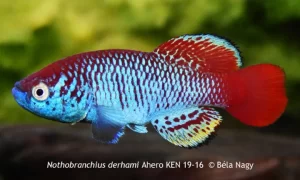
Nothobranchius derhami, wild-caught male. From: Wild Nothos: The Nothobranchius Site. https://wildnothos.wixsite.com
Nothobranchius derhami Valdesalici & Amato 2019, an annual killifish (Nothobranchiidae) described from a temporary ditch in Kenya. Patrick discovered this species in 1985 and observed part of its life cycle in the field.
In addition to these species, Patrick is also honored in the name of a genus: Derhamia Géry & Zarske 2002 is a monotypic genus of pencilfishes (Lebiasinidae) from the Mazaruni River basin of Guyana. Patrick discovered the type species (D. hoffmannorum) and collected the first specimens while evaluating the ecological and sociological impacts of a large hydroelectric dam at the type locality in 1975.
Although not schooled in taxonomic ichthyology (his doctoral thesis was on nitrogen cycling, soil and plant ecology), Patrick co-described several new taxa, including a new genus and species of dorado or jaw characin (Bryconidae), Chilobrycon deuterodon, and six species of killifishes: Laimosemion rectocaudatum, Anablepsoides elongatus, A. intermittens, A. iridescens, A. rubrolineatus, and A. speciosus.
Patrick was also a noted authority on the cichlids of Madagascar. With his late friend Jean-Claude Nourissat, he published Les Cichlidés endémiques de Madagascar in 2003, with an English edition, The Endemic Cichlids of Madagascar, in 2004.
Cichlid expert Juan Miguel Artigas Azas has written a tribute to his friend, including many photos and a link to a charming video of Patrick acting out the reproductive behavior of a Firemouth Cichlid (Thorichthys meeki) while wearing a cichlid costume.
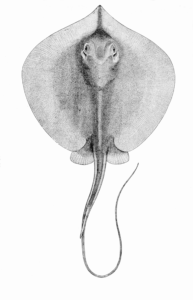
Hypanus sabinus, Atlantic Stingray. Illustration by H. L. Todd, from a specimen collected at Galveston, Texas, by David Starr Jordan. Courtesy: NOAA Photo Library.
22 February
Hypanus sabinus (Lesueur 1824)
Hypanus sabinus — until 2016 known as Dasyatis sabina — is the Atlantic Stingray, a common coastal resident of the Western Atlantic from Chesapeake Bay to the Gulf of Mexico. It was described as Trygon sabina by Charles Alexandre Lesueur (1778-1846), a French naturalist who lived and studied fishes in the United States from 1816 to 1837. Lesueur did not explain the etymology of “sabina,” nor did he offer any clues. Historians (myself included) have struggled to explain the name. Even Jordan & Evermann’s monumental Fishes of North and Middle America (1896-1900), which called upon a linguist and classical scholar to explain fish names, is silent on the name’s etymology. Recently I had occasion to take another look. I believe I have figured the name out, or at least have a viable explanation — actually, two explanations — to propose.
According to Brown’s Composition of Scientific Words (1956), “sabina,” is from the name of the Sabine Juniper, Juniperus sabina, a popular ornamental shrub from the mountains of central and southern Europe and western and central Asia. Boschung & Mayden in their 2004 book Fishes of Alabama cite an “in litt.” manuscript by elasmobranch biologist George Burgess, who suggests that the reference to the Sabine Juniper, “used in folk medicine,” is “probably a reference to the flattened shape of the [ray’s] body.” I find this explanation — comparing the shapes of the ray and the juniper — rather far-fetched. But the allusion to junipers in general has merit (more on that below).
Last year, The ETYFish Project’s resident Greek and Latin scholar Holger Funk suggested that sabinus may be derived from the Latin sabulum, meaning coarse sand or gravel, referring to the ray’s occurrence in shallow coastal waters over a sandy or silty bottom. Unfortunately, Lesueur did not mention habitat in his description.
Last week, I added a book to my library, Wildlife of Florida’s Springs: An Illustrated Field Guide to Over 150 Species, written by Sandra Poucher (Palm Beach, Fl.: Pineapple Press). I was delighted to see that the author — the co-owner of production company specializing in documentaries and print materials related to karst hydrological exploration (underwater caves) — cited The ETYFish Project and two other articles I had written. But I was not delighted to see that she had apparently trumped ETYFish by presenting a new and seemingly credible explanation of sabinus.
According to Poucher, sabinus “might refer to Sabin Berthelot (1794-1880), a French naturalist and ethnologist who lived in the Canary Islands and a contemporary of Lesueur.” Intrigued, I began exploring the Lesueur-Berthelot connection. I had accumulated a fair amount of biographical information on Lesueur during my research on Ameiurus natalis, which Lesueur cleverly named in honor of a French fisheries inspector. (See NOTW, 7 Aug 2019.) But I found no evidence that Lesueur and Berthelot had any kind of relationship, either personal or professional. I found no mention of Berthelot in Lesueur’s writings, nor any mention of Lesueur in Berthelot’s. I’m not saying no such relationship existed. I’m just saying I didn’t find one. While I liked Poucher’s explanation, I wish there was evidence to support it.
I turned my attention to another North American fish with a similar name: Miniellus sabinae (Jordan & Gilbert 1886), the Sabine Shiner, named for its discovery in the Sabine River of Texas. Curious if Lesueur’s sabina and the name of the Sabine River shared an etymological connection, I looked into the name. I learned that the “Sabine” name came from early Spanish explorers who called the river Rio de Sabinas because of the extensive growth of bald cypress trees, which they called sabinas, along the lower river.
And then it hit me.
The holotype (now lost) of Lesueur’s Trygon sabina was collected during an 1817 expedition to Florida sponsored by the Academy of Natural Sciences of Philadelphia (ANSP). Lesueur was not on this trip, but his good friend was — entomologist and malacologist Thomas Say (1787–1834). (Lesueur had named the Bluntnose Stingray Raja [now Hypanus] say in honor of his friend in 1817.) The expedition included a boat trip up the St. Johns River. Say was told that the river was teeming with fish. He was excited at the prospect of catching many of them for Lesueur back in Philadelphia, but managed to collect only a few even after repeated attempts with casting nets and hook and line.
We do not know if Lesueur’s Trygon sabina was caught in the St. Johns River, but we do know that the ray occurs there. In fact, Atlantic Stingray in the St. Johns River system of Florida represents the only permanent, reproducing freshwater elasmobranch population in North America.
We also know this about the St. Johns River: Bald cypress trees occur there as well, in addition to many other wetland locations throughout Florida. In 1817, long before the draining and development of Florida’s land, bald cypress trees must have been a conspicuous feature of the landscape.
Also in 1817, Florida was still a colony of Spain. So it’s reasonable to assume that the locals the ANSP party encountered on the St. Johns River (and other inland collecting sites) called the bald cypress trees by their Spanish name, sabinas.
With this information, a new explanation for the meaning of Lesueur’s sabina emerged: He named the ray for the flood-tolerant bald cypress trees — the sabinas of Spanish colonists — that were no doubt common along the coastal and inland waters of Florida where the Atlantic Stingray was first collected for science.
I shared this explanation with Lucas C. Majure, Assistant Curator and Keeper of University of Florida Herbarium at the Florida Museum of Natural History. He says it makes “perfect sense.” But he doesn’t rule out the Juniperus connection mentioned above. Cypress trees (Taxodium) and juniper trees (Juniperus) are members of the same family (Cupressaceae). Members of both genera are also commonly called sabina. In the Dominican Republic, for example, Juniperus forests are called sabinales. What’s more, Dr. Majure said, “Juniperus often occurs quite close to brackish/salt waters, such as of the Gulf or Atlantic coasts, as they are quite salt tolerant. Anyway, perhaps the name could also refer to the presence of junipers?”
Cypress tree or juniper tree? Take your pick. Either way, the explanation fits, a tidy combination of etymology, history, geography and — somewhat surprising for a fish name — botany as well.
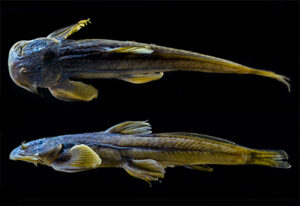
Exostoma dhritiae, holotype, 52.8 mm SL. From: Singh, P., L. Kosygin, S. D. Gurumayum and S. Rath. 2022. Exostoma dhritiae, a new sisorid catfish (Teleostei: Sisoridae) from the Brahmaputra River drainage, Arunachal Pradesh, India. Zootaxa 5219 (2): 165-174.
15 February
Exostoma dhritiae Singh, Kosygin, Gurumayum & Rath 2022
In August 2021, entomologist Dhriti Banerjee became the first female director of the 105-year-old Zoological Survey of India. In December 2022, a sisorid catfish was named in her honor — Exostoma dhritiae, which occurs in the Brahmaputra River basin of Arunachal Pradesh, India. The authors honored Dr. Banerjee for her “contribution to knowledge of the fauna of India.
The Zoological Survey of India (ZSI) was established on 1 July, 1916, with the primary objective of inventorying and documenting the exceptionally rich animal life of what was then called the “British Indian Empire.” Since its founding, ZSI zoologists have documented 102,718+ animal species in the country, representing approximately 6.52% of all known animals in the world. This includes 2,546+ species of fishes — roughly 11% of the world’s species — with two dozen or more being discovered and described every year.

Thomas Nelson Annandale

Dhriti Banerjee
The founder and first director of the ZSI was British zoologist-anthropologist Thomas Nelson Annandale (1876-1924). Annandale described several fishes from India, including three genera and 19 species still considered valid today. Eight currently valid fishes were in turn named after him.
In 2015, to help commemorate ZSI’s upcoming centenary, Dr. Banerjee was part of a team that determined where Annandale was buried.
Annandale died from malaria at the age of 47. According to some records, he was laid to rest at the South Park Street Cemetery in Central Kolkata (then known as Calcutta), India. But Annandale’s tombstone could not be found. Eventually, Dr. Banerjee and her colleagues discovered that Annandale’s remains had been moved to the Scottish Cemetery, established in 1820, catering to the specific needs of the large Scottish population in the Kolkata area. The Scottish Cemetery, abandoned in the 1950s and neglected following India’s independence, had fallen into disrepair. Most of the tombstones lie broken, defaced and forgotten. Weeds obscured the carvings. Annandale’s tombstone was unclean and the lead filling on its inscription had corroded
“We had a difficult time looking for Annandale’s tombstone,” Dr. Banerjee said. (It took them three days). “But it was an extremely rewarding experience.”
Annandale’s tombstone was cleaned and its inscription re-painted. Six years later, the zoologist who helped preserve and commemorate a part of ZSI’s history made ZSI history herself.

Cottus schitsuumsh, holotype, male, 91 mm SL. Illustration by Emily Harrington. From: LeMoine, M., M. K. Young, K. S. McKelvey, L. Eby, K. L. Pilgrim and M. K. Schwartz. 2014. Cottus schitsuumsh, a new species of sculpin (Scorpaeniformes: Cottidae) in the Columbia River basin, Idaho-Montana, USA. Zootaxa 3755 (3): 241-258.
8 February
Cottus schitsuumsh LeMoine, Young, McKelvey, Eby, Pilgrim & Schwartz 2014
One of the rules for coining a zoological epithet is that it must be pronounceable. Proposing to name a fish “dpjjlyzpyk,” for example, would almost certainly be met by eye rolls, derision and, even worse, rejection from the International Commission of Zoological Nomenclature. But there’s no rule against a name that’s exceedingly hard to pronounce. That’s often the case with names derived from obscure local or indigenous languages. We featured one such name, that of the Peruvian cichlid Tahuantinsuyoa macantzatza, in a previous NOWT (21 May 2014). The specific epithet of this freshwater sculpin requires a similarly difficult twist of the tongue.
Cottus schitsuumsh occurs in the upper Columbia River basin of northern Idaho and western Montana (USA), where it is common to abundant in cool-to-cold tributaries with cobble and gravel bottoms. Its name is a phonetic notation of the spoken word used by the first peoples who inhabited portions of northern Idaho and western Montana, now recognized as the Coeur d’Alene Tribe. (In fact, the Coeur d’Alene Tribe helped in choosing the name.) In modern usage it means “those who were found here” and refers to the people of this tribe. The current distribution of C. schitsuumsh overlaps with most of the historical homeland of this tribe.
The authors helpfully tell us that “schitsuumsh” is pronounced s-CHEET-sue-umsh.
The sculpin’s common name, Cedar Sculpin, refers to a common riparian tree in the area, Western Redcedar, Thuja plicata.
The generic name Cottus — or at least the word it’s based on — originated in antiquity. It’s a Latinization of the Greek kóttos (κόττος), kṓthos (κῶθος) and a few similar words, denoting a bulging head, used as a name for small freshwater fishes with a large head. The father of taxonomy, Carl Linnaeus, permanently affixed the name to sculpins in 1758. The generic names Gobio (gudgeon) and Gobius (goby) have the same etymological source.
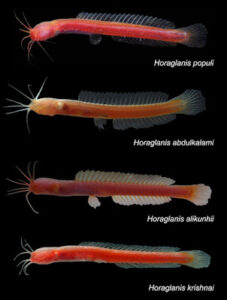
The species of Horaglanis. From: Raghavan, R., R. L. Sundar, C.P. Arjun, R. Britz, and N. Dahanukar. 2023. Evolution in the dark: unexpected genetic diversity and morphological
stasis in the blind, aquifer-dwelling catfish Horaglanis. Vertebrate Zoology 73 57–74.
1 February
Horaglanis populi Raghavan, Sundar, Arjun, Britz & Dahanukar 2023
Many fishes are named after people. This fish is named “of the people.”
Horaglanis populi is the fourth described species of Horaglanis, a genus of blind catfishes (family Clariidae) that inhabit homestead dug-out wells (5-10 m deep) and underground lateritic aquifers in Kerala State, India.
In order to learn more about these rarely-seen fishes, ichthyologists have conducted a “citizen science” campaign in Kerala. According to the authors, this campaign “has helped raise awareness of the subterranean fauna of southern India, and this has in turn dramatically increased the number of occurrence reports of these interesting fishes. It has also led to more specimens becoming available for research. Interested citizen naturalists have, no doubt, been at the forefront of aiding improvement of our knowledge of Horaglanis, especially through making available rare observations, photographs, videos and specimens.”
The catfish’s name honors these citizen scientists. The specific epithet populi is the genitive of the Latin noun populus, meaning people. The authors credit the “invaluable contributions made by interested members of the public in the southern Indian state of Kerala, helping to document the biodiversity of subterranean and groundwater systems, including the discovery of this new species.”
So far, all five names associated with Horaglanis honor people. The other four are:
Horaglanis Menon 1950 — in honor of ichthyologist Sunder Lal Hora (1896-1955), Director, Zoological Survey of India, “under whose inspiring guidance and kind help” Menon’s study was completed; glanis, sheatfish (Silurus glanis), now used as a general term for catfish
Horaglanis abdulkalami Subhash Babu 2012 — in honor of the former president of India, Dr. A. P. J. Abdul Kalam (b. 1931), “who ignited young minds towards the real world of Science and Technology”
Horaglanis alikunhii Subhash Babu & Nayar 2004 — in honor of “distinguished” aquaculturist Kolliyil Hameed Alikunhi (1918-2010), for his contributions to fishery science in general and Indian fisheries in particular
Horaglanis krishnai Menon 1950 — in honor of Mr. N. Krishna Pillay, who collected holotype after draining a well
25 January
The meaning of Dalatias: three speculations
A more-detailed version of this essay, with references, is available here.
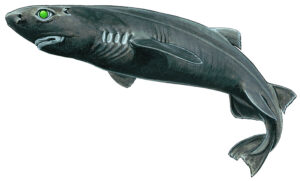
Dalatias licha. Illustration © Marc Dando. From the Shark Research Institute.
Dalatias licha, the Kitefin Shark, is a predatory shark that occurs in deeper ocean waters (200–600 m) around the world. The genus was named and described by the brilliant but eccentric naturalist Constantine Samuel Rafinesque (1783–1840). One aspect of his eccentricity was his penchant for coining names that make little etymological, grammatical or biological sense. Dalatias is one such name.
No one knows what it means.
With the help of Holger Funk, our resident expert on the ancient names of fishes, we took a closer look at Dalatias. We came up with three speculative possibilities but nothing conclusive.
SPECULATION #1 Dalatias is derived from the Greek dalós, meaning torch, lamp or lantern. This would seem a reasonable explanation since Dalatias licha is bioluminescent. Trouble is, this fact was discovered and reported only recently (2021). Was Rafinesque two centuries ahead of his time in describing this genus? We think not. It seems to us that something as remarkable as bioluminescence would be mentioned in Rafinesque’s brief description. It is not.
SPECULATION #2 Interestingly, dalós, in addition to designating a burning torch, can also refer to a torch that is burned out, charred or black. In this way, dalós can serve as a synonym of black. Dalatias licha is indeed a uniform brown-to-blackish shark. This explanation would have a semblance of credibility had Rafinesque described its color. He did not.
SPECULATION #3 According to Hesychius of Alexandria, dalós is another name for melánouros ichthýs, “blacktailed fish,” most likely referring to Oblada melanura, the Saddled Seabream, named for the black spot on its caudal peduncle. This is potentially relevant since Rafinesque called his shark Dalatias sparophagus. The specific epithet (-phagus, eater, devourer), according to Rafinesque, reflects what the shark was called among Sicilian fishers, Mangia-Luvaro, referring to how it likes to eat “Luvari” (presumably the Louvar, Luvarus imperialis) and other species of the then catch-all genus Sparus (hence sparophagus), which at the time included Oblada melanura. If Rafinesque named D. sparophagus after the shark’s preferred prey, might the generic name Dalatias also be a reference to the same? It could be. But the possibility is so convoluted that we can’t imagine someone even as peculiar as Rafinesque would coin such a peculiar name.
The etymology of “licha” is also unclear. “Licha” is a French variant of the Italian leccia (“acorn of a holm oak”), used as a vernacular name for different kinds of fishes, all of which have an acorn-like (oblong-oval) shape. According to one Italian etymological dictionary, leccia was also a vernacular for sharks (although sharks do not resemble acorns). In 1780, naturalist Pierre Marie Auguste Broussonet published the first account of Dalatias licha, which he called “La Liche.” Broussonet’s account served as the basis for the shark’s first Linnaean name, Squalus licha, proposed by zoologist Pierre Joseph Bonnaterre in 1788.
Another reference indicates that lichia, licha and liche are etymologically related to the Greek lýchnos or lychnískos, meaning shiny, perhaps referring to the silvery color of some carangid fishes. Why liche would also apply to a blackish shark is not explained.
 18 January
18 January
Edwin “Phil” Pister (1929-2023)
On August 18, 1969, a fishery biologist for the California Department of Fish and Game named Edwin “Phil” Pister held the fate of an entire vertebrate species — the Owens Pupfish (Cyprinodon radiosus) — in two buckets.
The pupfish was once a common inhabitant of the vast marshlands that stretched throughout eastern California’s Owens Valley. But decades of habitat destruction and the introduction of nonnative largemouth bass (“chainsaws with fins,” Phil called them) reduced the pupfish’s population to just one: a room-sized spring-fed pond called Fish Slough. The pond was almost completely dry when Phil got the call. He dropped what he was doing — ironically, planning the introduction of nonnative trout into a manmade reservoir — and gunned it to Fish Slough.
There was no time to think. Phil and a colleague netted the surviving 800 pupfish, placed them into three wire mesh cages, and sunk the cages into the main channel of the slough. Later they would scout out more favorable locations and move the fish again. After a quick dinner break Phil returned to complete his work, only to discover hundreds of dead and dying pupfish. Unfortunately, in his haste to rescue the species, Phil had placed the cages in eddies just outside of the slough’s main current.
Dangerously low water levels and insufficient oxygen were taking their toll on the overcrowded pupfish, already stressed by unavoidably rough treatment on a hot summer afternoon in the middle of the desert. Temporarily alone in the marsh, Phil ran to his pickup truck, grabbed the only two buckets he had, and netted the gasping fish. He had to find someplace to move them now or the species would go extinct.
Pister was scared to death. As he lugged the two buckets, each weighing more than 30 pounds, over the uneven marsh terrain, he worried about tripping over barbed wire or stepping into a rodent burrow. “Please don’t let me stumble,” he pleaded with himself. “For a few frightening moments,” he later remembered, “there was only myself standing between life and extinction.”
Phil did not stumble. The Owens pupfish survives in two well-protected refugia. And Phil went on to found and lead the Desert Fishes Council (DFC). The mission of the DFC is to preserve the biological integrity of desert aquatic ecosystems and their associated life forms, to hold symposia to report related research and management endeavors, and to effect rapid dissemination of information concerning activities of the Council and its members.
This morning we woke up to the sad news that Phil passed away yesterday from heart failure.
Two desert fishes are named in Phil’s honor:
The Palomos Pupfish, Cyprinodon pisteri Miller & Minckley 2002, occurs in the Lago de Guzmán basin of Chihuahua, Mexico. The authors wrote: “For almost four decades, Phil Pister has unerringly and effectively performed the daunting task of preserving the integrity of natural aquatic habitats and biotas in North American deserts, along the way teaching others to do the same. His infectious and tireless persistence, enthusiasm, optimistic outlook, and unique capability to redirect conflicting views toward common goals have led to significant and enviable successes in equating science and a strong environmental ethic with political reality.”
Fundulus philpisteri García-Ramírez, Contreras-Balderas & Lozano-Vilano 2007 occurs in Baño de San Ignacio and nearby springs in Nuevo León, Mexico. The authors honored Phil for his dedication to the study and teaching of ichthyology, and for promoting the conservation of the desert fishes and their ecosystems.
The common name of F. philpisteri is Conservationist Killifish.
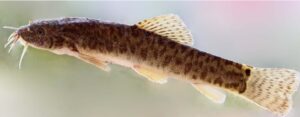
Paracanthocobitis putaoensis. Photo by Chen Xiao-Yong. From: Lin, F., Z.-Y. Chen, K. M. Myint, and X.-Y. Chen. 2023. Paracanthocobitis putaoensis, a new loach species (Cypriniformes: Nemacheilidae) from the Irrawaddy basin in northern Myanmar. Zootaxa 5227 (2): 265–278.
11 January
Paracanthocobitis putaoensis Lin, Chen & Chen 2023
Every year around this time we highlight the first-described new fish species of the New Year. For 2023 it is Paracanthocobitis putaoensis.
P. putaoensis is a nemacheilid loach described from Tanjar Stream, a tributary of the Mali Hka River, Irrawaddy River Basin, in Kachin State in northern Myanmar. It is distinguished from all other species of the genus Paracanthocobitis by its incomplete lateral line, a suborbital groove in adult males, and a well-developed axillary pelvic lobe. The loach inhabits slow-flowing streams with a substrate of small gravel and stone.
Its name, with the Latin suffix –ensis (denoting place), refers to Putao, the district in Kachin State, Myanmar, where it occurs.
By our count, 304 new fish species were described in 2022, well under the average of 404 new species described annually since 2003.

Eidinemacheilus smithi, holotype, apparently an immature male, 35.5 mm SL. O = position of orbit. Illustration by Gordon Howes. From: Greenwood, P. H. 1976. A new and eyeless cobitid fish (Pisces, Cypriniformes) from the Zagros Mountains, Iran. Journal of Zoology (London) 180 (1): 129–137.
4 January
Eidinemacheilus smithi (Greenwood 1976)
Eidinemacheilus (originally Nemacheilus) smithi is a blind cave loach known only from spring and subterranean waters of the Tigris River basin in the Zagros Mountains of Iran. The loach was described by Peter Humphry Greenwood (1927-1995), Curator of the Fish Section of the British Museum (Natural History). Greenwood named it in honor of the English writer, explorer and television personality Anthony Smith (1926-2014), who collected the holotype. Greenwood said Smith took “great pains (some of them physical)” in collecting, “not without considerable difficulty,” the holotype. Curious as to what these “great pains” were, I made an unexpected and altogether pleasant discovery:
Anthony Smith recreated his 1976 expedition to Persia (Iran) to collect this blind cave loach for a 1977 television documentary, available on YouTube.
In the first half of the documentary, Smith explains the desert “qanats” of Iran. Qanats are underground channels or tunnels constructed to lead water from the interior of a hill to a village below. I found it fascinating. To skip ahead to the “good” (i.e., fish) part, fast-forward to the 35:46 time mark. It’s well worth watching. (Curiously, the “physical” pains that Greenwood alluded to in his description are not mentioned.)
Especially interesting are scenes of Smith discussing the fish with Greenwood at the British Museum. Near the end of the documentary, Greenwood deposits the holotype in a jar among stacks of preserved fishes in the basement of the museum. I especially like the last line:
“Reverentially, we placed it among other famous fish,” Smith says in the voiceover, “having found it by a cave in Persia, only to bury it in this other kind of cave.”
The name of the genus Eidinemacheilus deserves mention as well. Proposed by Hashemzadeh Segherloo, Ghaedrahmati & Freyhof in 2016, Eidinemacheilus honors Eidi Heidari, Lorestan Bureau of Environment (Iran), the ranger who protects the spring in which E. smithi occurs.